DEAR SIR,
I HAVE at last, after many hard struggles, and many a painful hour, labouring under a tedious disorder, furnished the essay on the cultivation of the Vine, &tc.
which I now send you.
Nothing but the love of my country and the good of mankind could have tempted me to appear and expose myself to public view.
I have, to the utmost of my skill and knowledge, endeavoured to lay open and explain every part of this undertaking, yet new to America; though an undertaking
as antient at least as the days of Noah;
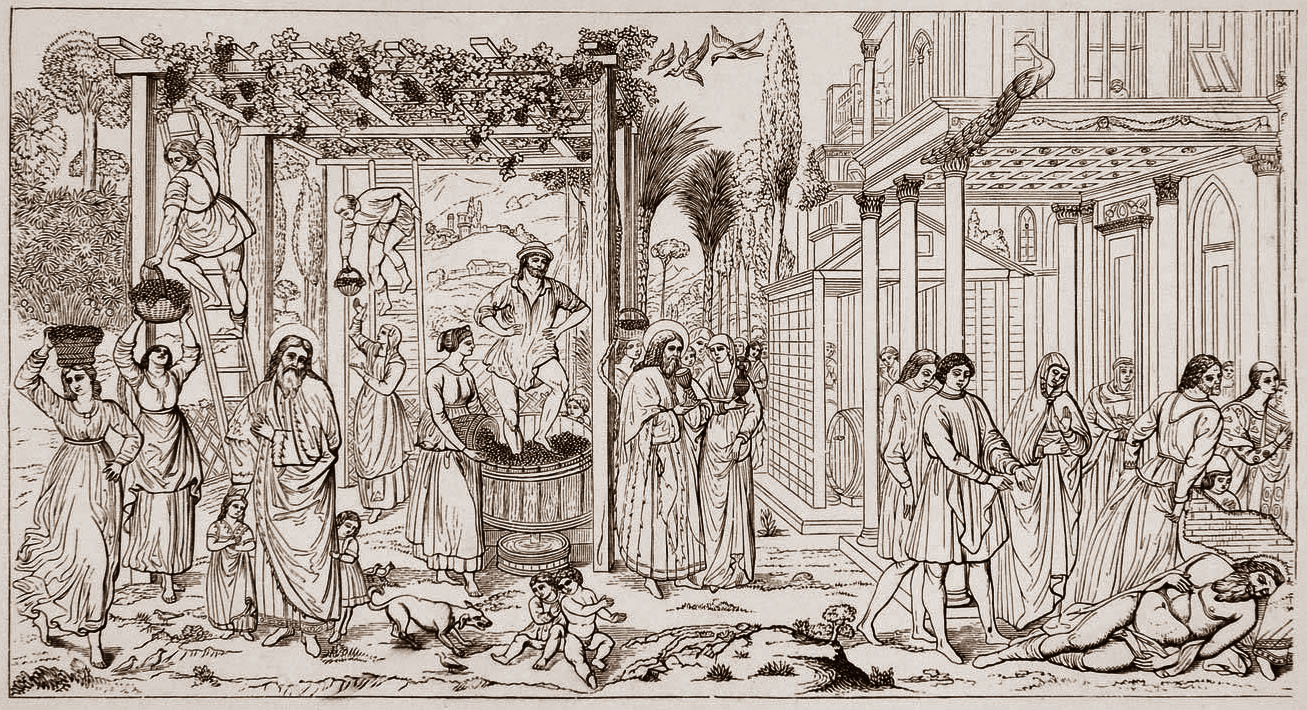
and yet what seems strange to tell, it is an art that has not yet arrived at perfection,
but is still visibly capable of some essential improvements. That America should give the finishing stroke at last to a work, that has been in hand
above four thousand years; and what is still more strange, a work every part of which, is an experiment, if attended to; I say that the completing
of such a work should be left to the genius of America, no doubt would give the people of America a good deal of pleasure. That this will be the case,
I cannot yet take upon me to say; but I think there are some hints now offered, which if steadily pursued, and improved by early experiments,
the making of wines and the preserving them, will soon arrive at greater perfection, than yet it has been done.

The success and perfection of every undertaking depends upon setting out right: Indeed the people of America have greatly the advantage
of the people of Europe, in things of this nature, because we begin where they leave off, and we are free from the force of all their prejudices
and erroneous customs; but then we must determinately act like men, and judge for ourselves, and not implicitly follow them, without the use of our
own reason: Let us then suppose that every art is capable of improvement, and let the people of America try the strength of their own genius. They may hit on things that
have not been thought of before; for we yearly see, that the arts and sciences too, meet with constant additional improvements; and why should
the people of America be secluded from the honour and pleasure of being serviceable to mankind in their turn. We must expect to meet with
all the discouragements, that the artifice of France, Spain and Portugal can give us; we shall be told, that our country is too new, our soil is not fit,
and our climate is the reverse of that of wine countries; besides that without the help of experienced vignerons it will be impossible for us to make any hand of it;
that as to books, they are so erroneous, that there is no dependence upon them, and abundance of such stuff. But let not the people of America be dupes to France,
or any set of designing men.
Why the people of America, that trades in wines, should give opposition to the undertaking, I cannot conceive. They and their children will be dead and gone, before it can arrive
to such a pitch, as to interrupt their trade; besides it must, when brought to perfection, be a double advantage to such men; for it is well known, that the wine merchants,
in all wine countries, gain more by wine than the people that make it; and their gain will still be increased, when they come to send it home to the mother country.
The papers I send you are only a rough draught, as you will easily discover; I have not strength to go over it again, to range all the parts under different
heads, in order to reduce them to proper chapters for the ease of the reader; I must leave that to the printer, and to those that direct the press.
I am, &c.
E.A.
Monmouth, New Jersey,
Shrewsbury, May 10 1769.
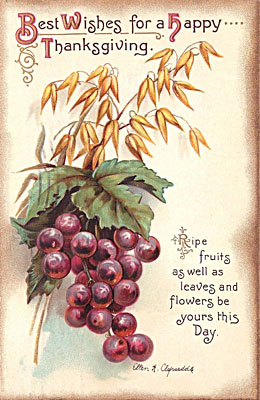
An Essay on the CULTIVATION of the VINE, &c.
Introduction
THE vine, if considered in its full extent of pleasure, profit and usefulness to man, challenges, next to what affords us bread,
the chief place among the vegetable creation; its fruit, when thoroughly ripe, is pleasing to the eye, grateful to the table, comforting to the stomach,
refreshing to the body when eaten with caution and moderation, and greatly contributes to health. Its juices, when expressed and rightly fermented and
purified according to art, partake of a noble spirit truly homogeneous and fit for the use of man. They gladden his heart, remove to
a distance his troubles and cares, cause him to forget his poverty and low estate, and raise him to a level with the rich and great: They enliven
his thoughts, exhilerate his spirits, cheer his soul, and for a time make him as happy as his present condition is capable of. Wise and happy
is the man, that shuns excess, that prudently avoids turning this cordial into a cup of poison, and moderately enjoys the blessing with a thankful heart.

Wine is a very considerable branch of trade. The many advantages that must arise to the Colonies from the making it, as well as to the mother country,
are so great and so well known, that I need not go about to describe them at large; to touch upon them is sufficient.
The planting of vineyards, the cultivation of vines, the making of wine, and casks to preserve it, must employ and give bread to a great number of people;
the freight and a profitable remittance, must enrich the merchant; and the being supplied from the colonies with wine, in exchange for her manufactures,
must be a considerable saving to Great-Britain.
Whoever considers the general climate of North-America, the soil, the seasons, the serenity and dryness of the air, the length and intenseness
of the heat, the fair and moderate weather, that generally prevails in the fall, when grapes are coming to maturity, and arrive at their greatest
perfection; whoever compares the present state of the air, with what it was formerly, before the country was opened, cleared and drained, will find that,
we are every year fast advancing to that pure and perfect temperament of air, fit for making the best and richest wines of every kind.
Such has been the bounty and goodness of heaven, that there are vines adapted to every country, to every region, from fifty degrees both north and south latitude down to
the equator; and the countries beyond these may easily be supplied by traffic, so that all the sons of men may partake of this general, this universal blessing.
It is not every vine, that is for every country: Some are earlier, some are later ripe; some are tender and delicate, and will not stand the
severity of winter, others are hardy and robust, and will stand any weather: Hereafter I shall range them in proper and distinct classes, and adapt the
different sorts by name to the different climates in America, where they may be propagated with safety and to the best advantage.
A vine, from a stick or cutting, begins to bear fruit the third year, the fourth year it bears more, and the fifty year you may make wine;
and for your greater encouragement, from that time until it attains the full age of man, it increases in value and yields a richer wine; and if from the
beginning, it be carefully pruned, duly manured and properly cultivated, it will generously reward you for all your labour,
expence and care, and will hold good above an hundred years, as most writers affirm.
But then it must be tended by a careful and steady hand.
It will not bear to be slighted, or neglected. If you do not manure the ground and keep it in good heart, your vine will bear no fruit; if you neglect to cultive the soil
and keep it clean, your fruit will be knotty, and starved, and will not come to maturity; if you suffer the stakes or props to fall,
and your vine to sprawl on the ground, the fruit will not ripen, but remain austere, and will not make good wine. Wine is too rich a juice to
be made from a barren soil, or by lazy idle slovens. Such men should never undertake a vineyard. They not only hurt themselves, and bring the
thing into discredit, but hinder others, who are fit for the undertaking, from making the attempt.
If a vineyard does not succeed, the fault is in the man, not in the vine. It will flourish and prosper under a careful diligent hand; but it will
degenerate and run wild under the hand of sloth and idleness.
A gentleman of Rome, who took great delight in vineyards, some of which he had raised with his
own hands, wrote a very elegant piece upon the culture of vines, and in the most pathetic terms recommends it to the people of Italy,
as the most profitable, as well as agreeable amusing undertaking. Among many other encouragements, he tells them this story: "Pavidius Veterensis, a neighbour of my
uncle, had a vineyard and two daughters. Upon the marriage of one of them, he gave as her dowry, one third of his vineyard; and then doubled his diligence,
and cultivated the remainder so well, that it yielded him as much as the whole had done before: Upon the marriage of his other daughter, he gave with her
one other third of his vineyard; and now having but one third of the whole left; he so manured and cultivated it, that it yielded him full as
much as the whole had done at first."
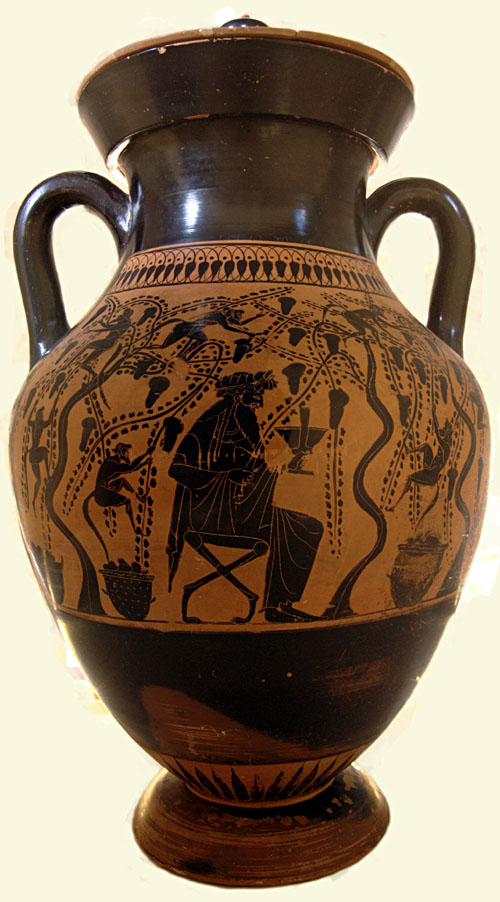
This ingenious author accuses many of his countrymen of having begun this work with seeming resolution, and of having carried it on for some time
with assiduity, but before they had brought it to perfection, they flagged, and for want of steadiness and a little longer perserverance, lost their
money, their labour, and all their prospects. At the time he proves to a demonstration, from exact and minute calculations, the great advantages of
vineyard notwithstanding the great expence the Romans were at in buildings, inclosures, workmen and magnificent works, and brings his own
vineyards, which were well known, as proofs of all he had said.
The vine that naturally runs low, and cannot rear itself without a support, is for this end provided with tendrils, by which,
like so many hands, it lays hold on every thing it meets with, that may raise it, and by these aids it expands, and become so luxuriant, that to prevent
its running out into useless wood, the dresser is obliged to prune off its superfluous wandering branches; after which from the standing joints,
in the ensuing spring, the little bud called the gem, pushes out the new shoot, whereon the tender young grape is formed; which gradually swelling by
nourishment from the earth, is at first austere to the taste, but guarded with leaves around, that it may neither want due warmth, nor suffer by too
scorching rays, it ripens by the Sun's enlivening beams, and acquires that delicious sweetness and beautiful form, that equally pleases both the taste
and the eye; and then enriches the world with that noble liquor, the advantages of which I need not name. Yet it is not the sense of these, nor of all
the advantages of husbandry, that so nearly affect us, as the pleasure I find in their culture alone; such as ranging the vines and their
supporting perches in exact and even rows, in arching and binding their tops, lopping off the woody and barren, and training the fruitful
branches to supply every vacancy, and then contemplating the beauty and order with the process of nature in the whole.
Of the planting and management of the Vine.
Situation and soil of a vineyard.
THE first thing necessary to a good vineyard is a proper plot or piece of ground. Its situation should be high and dry, free from springs and a wet spewy soil. Its aspect
or front should be towards the south and south-east. Though the ground be not a hill, yet if it be high, open and airy, and gradually ascends toward the south
or south-east, it will do very well. If it be a fruitful hill, it will do better. But if it be a mountain, with a rich soil, it will be best of all; for the higher
the vineyard, the richer the wine.
The soil most natural to a vineyard, and such as produces the sweetest grapes, and the richest strongest wine, is a rich mould mixed with sand. The newer and fresher
the ground, the better; such a soil may be found on a rising ground and on some hills, but very seldom on the sides of mountains; for here the soil is generally
stiff and clayey, so ordered by Providence, as being less subject to be washed away by hard rains; but this stiff soil on the side of mountains differs greatly
from clay grounds below; the winds and air, and the Sun's heat so dry and warm it,
that it becomes a proper bed for vines, and renders them both prolific and productive of the richest wines.
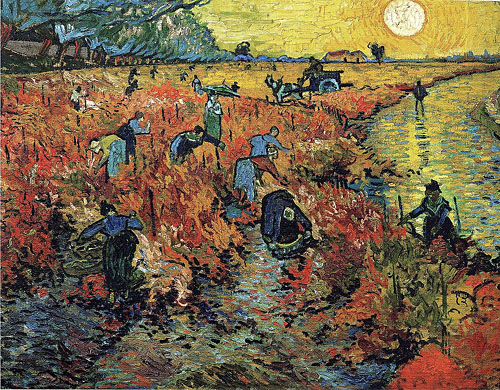
A rich warm soil mixed with gravel, or a sandy mould interspersed with large stones, or with small loose rocks, are also very proper for a vineyard. Rocks and stones,
if the soil be good, warm and dry, are no disadvantage to vines. On the contrary, they reflect great heat to the fruit, and thereby contribute towards
perfecting the wine, especially
if they are on rising ground on the declivity of a hill, or on the side of a mountain It is true they are attended with some inconveniences.
It is true they are attended with some inconveniences. It is more difficult to keep such a vineyard clean, to stake it well, to range the vines in proper order,
and regular form, to duing the ground, and gather in the vintage. But then, these rocks and stones will make a good, close, strong, and lasting fence.
On the sides of hills and mountains they are absolutely necessary to make low rough walls along the lower side of the vines, to preserve the good soil from
washing away. They serve also to keep the ground moist in hot dry times, when, but for them, the soil would be parched
up along such steep grounds. In short, there would be no such thing as raising vineyards on such grounds, were it not for rocks and stones.
For as it is necessary to keep the soil loose and mellow, it would all wash away with hard rains, if not prevented by forming a kind of rough
wall of stones along the lower side of each row of vines. Again, such lands are cheap, being unfit for other purposes, and generally yielding but
little timber or grass. They may therefore be purchased by poor people, who could not afford to go to the price of good land.
Lastly, these steep hills and mountains always yield the richest wines, the value and price of which will compensate for any extraordinary labour.
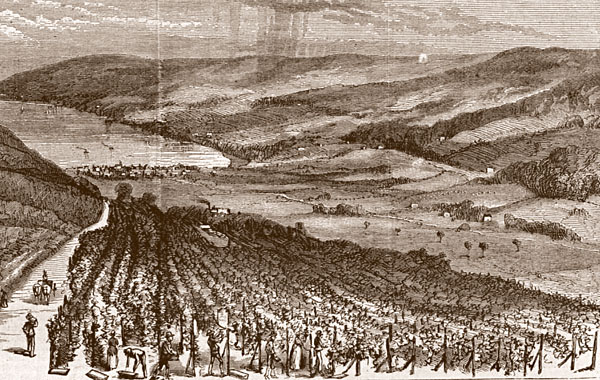
If the ground be worn and out of heart, it must be renewed and helped with dung, with fresh mould, with creek mud, with the rich soil
that lodges along the sides of brooks or rivers, or that settles in low placed at the foot of hills or mountains,
or by foddering cattle and sheep upon it and plowing all under it as deep as may be, till all be made
sufficiently rich, or by any other method, that shall best suit the owner.
After your ground is brought into good heart, and has been deep ploughed or dug and well harrowed, so as to be quite mellow, it must be well secured with a good close
fence, such as is fit to turn rambling boys, as well as cattle and hogs, for on this depends the success of the whole.
The vineyard nursery.
The next step to be taken, is to provide a sufficient stock of vine cuttings, not only enough to plant the vineyard, but a small nursery too If these cannot be
hard all at once, begin to lay up a year or two beforehand, and plant them in your nursery in even rows, at four inches distance,
and the rows three feet asunder, that they may be howed and kept clean; and scatter some short straw and chaff along between the rows
to keep the ground moist and the weeds down. Let the ground of your nursery be of good heart, but by no means so rich as the soil of your vineyard;
if it is, when the plants are removed into the vineyard, they will pine and dwindle, and seldom flourish and become fruitful.
The reason of planting the cuttings so close in the nursery is, to prevent their shooting their roots too far into the ground, which would render them very
difficult to take up without damaging the root, and more tedious to plant out.

Be not over fond of planting various sorts of vines in your vineyard, if you mean to make good wine. The most experienced Vignerons say, that grapes of one sort
make the best wine; that if they are mixed, they hurt the wine, by keeping it constantly upon the fret, by means of their different fermentations.
Be that as it may, I should recommend this practice, for reasons that operate more strongly with me, which are, that the more simple and pure wine is,
the more perfect it is in kind. Three different wines may be all good in kind and very agreeable, whilst distinct, but when mixed together become quite the reverse, and the
whole is spoiled. If my vineyard contained one acre of ground, I should choose to have but two sorts of grapes in it; if I meant to make a profit of it by selling
the wine, if it contained two acres, I would have four sorts in it; and if it contained three or four acres, I should not choose more.
But if it contained six, eight or ten acres, perhaps I might incline to have a greater variety; but then I shouold prefer those kinds that make the best
wines and such as do not come in at the same time, from whence I should reap many advantages. First I should not be overhurried in the time of vintage,
nor run the risque of having some spoil upon my hands, whilst I was making up the rest; again, if a season proved unfavourable, and some were cut off by
the inclemency of the weather, others, that were later ripe, might escape the injury. It is certainly best to plant each sort in a distinct
quarter by itself, if we mean to avoid confusion, and to reap every advantage.
Choose a vine appropriate to its location.
The next thing to be considered is the quality of the vines to be made choice of. This must be limited, and adapted to the climate where the
vineyard is planted. The most hardy and earliest ripe, will best suit the most northern colonies, I mean those of New-Hampshire, Boston,
Rhode-Island and Connecticut. As to those countries, that lie still farther north, they are not yet sufficiently cleared and open for the purpose.
The vines proper for these countries are,
| 1. The black Auvernat, |
The white Muscadine, |
| 2. The black Orleans, |
The Muscadella, |
| 3. The blue Cluster, |
The Melie Blanc, |
| 4. The Miller Grape, |
The white Morillon, |
| The black Hamburg, |
The white Auvernat, |
| The red Hamburg, |
The grey Auvernal, |
The first four numbered make the best Burgundy.
All these are ripe early in September.
All the foregoing sorts will do very well for the three bread colonies, viz. New-York, New-Jersey, Pennsylvania,
and the three Lower Counties; I mean for the clear and open parts of these countries; to which may be added
the following sorts, which I recommend by way of trial, they being more tender, but ripen in September; they
should have the warmest birth in the vineyard.

The Chasselas Blanc,
called the Royal Muscadine, |
The red Frontiniac, |
| |
The black Lisbon, |
| The grey Frontiniac, |
The Chasselas Noir, |
All the forgoing sorts will do very well for the colonies of Maryland, Virginia, and North-Carolina, to which
I shall add the following sorts, and recommend them for trial, but then they must have a warm place.
| The white Frontiniac, |
The black Damask, |
| The malmsey Muscat, |
The Chicanti of Italy,
which makes a rich wine
much admired in Italy., |
| The white Oporto, |
The black Oporto, |
All the abovementioned sorts will do well in South-Carolina, and in the colonies still farther south. To which I shall add
the following sorts, as being still more tender and later ripe.

| The raisin Muscat, |
The white Muscat of
Alexandria, |
The Alicant and Malaga
Raisin Grape, |
The gros Noir of Spain, |
The red Muscat of
Alexandria, |
The St. Peter's Grape, |
In many parts of Virginia, North and South-Carolina, and in Georgia, the soil is chiefly a hot dry sand, and what strength nature afforded has been
exhausted by tobacco, Indian corn, rice, &c. However these grounds, where they lie near to rivers and creeks, may easily be recruited;
for these rivers abound with rich mud, which is the best kind of manure for such lands, and it would be no great expence to
procure a sufficient quantity of it to cover a piece of ground large enough for a vineyard, especially if it be considered, what a
number of hands the gentlemen of these countries have, who might be employed at such times, when other business is not very urgent:
But then this mud must lie some time upon the ground, before it be mixed with the soil, at least a summer and a winter; for at first
it will bake very hard, and be very crude; but the winds, dews, rains and frosts, with the help of the Sun, will sweeten, mellow,
and bring it into a proper temper. Then it must be equally spread and well mixed with the soil. Thus may the land be recruited, and kept
in good heart, from time to time, and from a barren useless piece of ground it may become profitable both to the owner and his country.

Choosing the right part of the vine for September cuttings.
The nature and quality of the vines being considered and made choice of to suit the country you live in, the next
thing necessary to be known is, how to make choice of such parts of a vine, for cuttings to plant, as may be most
likely to grow and flourish, and also to produce healthy and fruitful vines, on which the success and profits of a vineyard very much depend. Know then, that
all parts of a vine are not equally good and fit for plants. If you have it in your choice, avoid all branches, that have not born fruit,
all suckers, nephews, lateral and secondary branches, and especially the long running barren branches. These different sorts
seldom produce fruitful vines. Choose therefore, your cuttings from the teeming part of the vine, from among those branches that were set
apart for bearing fruit; and among these, choose such as are short jointed, and have been most fruitful the last summer, so shall you
be sure to have fruitful and thrifty vines. Let them be cut down close to the old wood; for here the wood is ripest and most firm.
The upper part of the same branch is less ripe, and more loose and spungy, and more apt to fail, and very seldom makes so firm and lasting a vine.
However, where vines are scarce, and men have not these advantages in their power, they must do the best they can. These branches must
be trimmed and cleared from the nephews and the lateral or secondary branches; but in doing this, great care must be taken not to wound the buds
or eyes, which a careless hand is very apt to do. If the bud be bruised with the back of the knife, so that the cotton that lies
under the thin bark, that covers the bud, and is wisely intended to preserve it from the injuries of the weather, be rubbed off, the bud will perish.
Therefore as the buds lie close to these lateral branches, and are in so much danger of being wounded, it is best and safest to cut the branches
off, a little above the height of the bud, that the little stump or stub left behind may be above the top of the bud, so shall the eye be left secure,
and run to risque of being blinded.
These branches being thus trimmed remain whole and at full length 'till the next April, which in the northern colonies, is the best time for planting.
They should be separated from the mother plant, sometime in September, or as soon as the vintage is over, that being the best time for the trimming
of vines, because the wounds which the mothers receive are healed up, and securely closed from the severity of the winter season. If this work
be left 'till February or March, the parent suffers by her fresh wounds in long rains, sleets and frosts that follow; or if
the weather be favourable, she grows faint and exhausted by excess of bleeding, and her eyes are drowned in her own blood.
Preserving vine cuttings over the winter.
The best way I have found for preserving the cuttings through the winter, and which I therefore recommend for a general practice, is as follows.
At or near the north west corner of your vineyard or garden, the fence being good and close, let a small trench be dug five or six inches deep and wide,
and so long as may contain all your branches. In this plant them thick and close with the but ends down, and fill up the trench, as you go, with the ground,
that came out of it, and press it down well with your hand, all about the bottom of your branches; let the dirt rise two or three inches above the surface of the ground,
to prevent the water from settling about the vines, which would rot them. Between every sort, drive down two stakes
and fix a label to one of them to distinguish the vines from each other by their proper names.
Before you plant your vines in this manner, drive down two or
more crotches, according to the quantity of vines, at about three feet from the trench, and parallel with it, upon which poles are laid, to support the upper part
of the branches about twelve or fifteen inches from the ground. Thus they all lie sloping without touching he ground, which
preserves them from growing mouldy and from rotting. The vines then are covered with straw, laid lengthways upon them up and down a little
beyond the trench, so that the water is carried off beyond the foot of the vines by this straw roof; and yet the straw must not be laid on too thick,
lest it continue moist too long, and occasion mouldiness. Across the top, a pole is laid and across the bottom, and fastened down to prevent the
straw from blowing away. Thus they remained 'till spring.
Preparing for April cutting planting.
In the beginning of April when you are ready for planting, the weather being moderate and calm, the frost out of the ground,
and nature teeming with fresh vegetation, then cut your branches for planting. If one cutting from every branch be sufficient for
your purpose, then cut the lower part about twelve or fourteen inches long. But as it is most likely, that you will not be so lucky,
as to have enough of these, then do what necessity requires, and make two or three cuttings of every branch, not less than a foot long;
and having a trench made ready, place in it close together, the but or lower end down, and cover them up with earth to the upper eye 'till
you are ready to plant, carefully placing every sort by themselves, with a label denoting the kind. This direction is calculated
for the three bread colonies. The more northern colonies will be a month later, and the more southern colonies will be at least a month, some two months earlier;
they must conduct themselves accordingly. To these last colonies, I would recommend the cuttings to be longer, that they may be planted
deeper, the better to preserve the vines from excessive heat and droughts.
Your ground as I said before being well manured, and brought into good heart if old, or being naturally rich if new, and having been, at
least twice, deep ploughed and well harrowed the summer before, in the fall of the year it must be deep ploughed the third time,
and always across the hill or rising ground, and let it lie rough just as it is ploughed, all winter, which will greatly prevent washing,
and the frosts will mellow it and prepare it the better for vegetation.
In the Spring of the year, as soon as the ground is dry, let it be well harrowed both ways, with a sharp iron tooth harrow laid down
smooth and even; and take this caution along with you, which I now give once for all, never to meddle with the ground of your vineyard
when it is wet, or even moist at top, nay, I would have you avoid as much as possible, walked in at such a time. Your own experience
will soon teach you, the reason of this caution. For you will find, that the lighter and more open and loose the toil of a vineyard is kept,
the more the vines will flourish, and the more fruitful they will prove.
When your ground is in proper order, provide a small stake of four feet long for every vine; and begin to lay out your vineyard in the most regular
manner the nature and shape of the ground will admit of. If you mean to plough and harrow your vineyard, with a small single horse plough and a small corn harrow, you
must leave a border of ten or twelve feet on each side of every square, to turn your horse upon, least he tramples upon
and destroys the outside vines. There will be no need of such borders along the upper or lower side of the squares, unless you choose it for
regularity's sake; because your vineyard should never be ploughed up and down hill, but transversely, unless you mean to have it gullied,
and the rich soil washed away by hard rains.
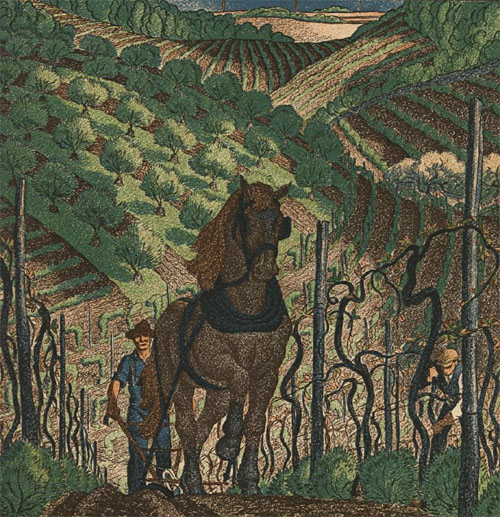
Laying out the vineyard square.
The following method of laying out a vineyard, I think is as easy, as regular and as expeditious as any, for a long square or a four square
piece of ground. Your squares being laid out, and having concluded how far your vines shall stand every way from one another, in which every
man is to please himself; you stretch a line of a proper length, and stitch small pieces of red, blue, green, or any
other colored cloth at such distance from each other as you mean to plant your vines. I will suppose eight feet, because upon the most mature deliberation,
I think that the best distance for vines to stand at in this country, as I shall afterwards shew more fully.
The line being ready, stretch it along the head or upper part of your square, so that a rag appears at each corner,
drive down a stake at every rag: This done, move your line down to the lower side of the square, which is oppsite to the first, and
stretch your line along that, having a rag at each corner, and drive down a stake at every rag; Then turn your line
the other way up and down, and fasten your line to the upper and to the lower outside stakes, so that a rag be at east stake, and drive down a stake at every rag,
and so go on from stake to stake, till the whole be completed. If you have been careful not to disturb or move the line, when you
drove down the stakes, and have driven them all on the same side of the line, your square will be uniform, and the stakes near the ground, will range exactly
every way.
If your vineyard be large enough to divide into four, six, or eight squares, or more, according to the different sorts of grapes you design
to have in it, and you are not pinched for room, you will find it very convenient on many accounts to have cross walks of twelve feet, between the squares,
not only to turn upon when ploughing, but for the carting in of dung, and placing it handily for dunging the vines, which will be a great saving
of labour, besides being attended with many other advantages.
Having staked your ground, which ought to be done when it is dry, because it will save you a great deal of labour, in making it loose and mellow again;
and having as many vine cuttings as you can plant in half a day, soaking in rich dung water, in a pail, which serves best to keep the plants upright, the butt ends being down, dig
holes at every stake larger or smaller, according to your own fantasy and judgment: For it matters not,
so they are deep enough to contain the plant. But here I must clear up a point, which has led many people into mistakes and
rendered this work more tedious, and that is the throwing into the holes, in which the vines are planted, rich mould mixed with old dung, thinking
that this must be a great advantage to the vine. This is a great mistake. For as soon as the vine shoots its roots, beyond this rich
mixture, into the common soil, which is many degrees poorer and colder, the roots, as it were, recoil and shrink back at a
coldness and poverty, they had not been used to, and the vegetation is stopped, and the plant dwindles into poverty and barreness; and
if you examine the plant at bottom, you will find that instead of extending its roots to their usual length, it has shot out a great number of small fibres
like threads, which extend no farther than the good mould and these being quite insufficient to answer the demands of nature, the plant perishes, or remains in
an inactive and barren state. Whereas, had the vine been planted in the common soil at first it would have met with no alteration, no sudden change
to check its growth. This shews that the soil should be well mixed; and let me tell you once for all, that the vine delights in a warm,
comfortable fruitful soil; but proves unfruitful and perishes in a soil cold and barren.
Yet a soil may be too rich, or made too rank by dung, and this extreme is also to be avoided But to return to planting our vines,
the holes being dug according to your mind, plant your vine, setting the foot forward from the stake, and bend it a little, without
cracking the bark, and bring it gently up against the stake, so that one eye only remains above the surface of the ground. Let not
the eye touch the stake, but look from it. Then mixing the ground well together, throw it in and press it gently about the vine, till the hole is
almost full, and throw the rest in lightly, without pressing, so that it may rise up to the eye of the vine, which ought to be
about two inches above the common surface. By this means, the vine will be preserved from drying winds and the hot Sun,
till it begins to grow.
Some place four or five paving stones about the foot of the vine, not so close but that the roots
may shoot out between them, and these they say, and I think with reason, condense the air in hot dry seasons, and nourish the vine with moisture,
and cool and refresh it when parched with excessive heats. In the northern colonies, the vines should be planted on the south side of the stakes,
for the sake of the Sun: In the southern colonies, they should be planted on the north side to avoid too great heat. The upper eye only should shoot out branches, from which the
head of the vine is formed. If any shoots should rise from below, which sometimes is the case, the sooner they are removed the better, these are
called suckers, and very much exhaust the vine. And thus you proceed till all be finished.
Return excess cuttings to your nursery.
When your vines are all planted, if you have any cuttings remaining, plant them in a sursery or along the north side of your stakes, for you
will have occasion for them, as many of your vines will miscarry, and the sooner their places are supplied the better.
If some of your vines do not shoot till July, do not give them up, they may grow notwithstanding. I have had many, that have
not shot till August, and yet have donw well. And here let me tell you that, the filling up all the vacancies, where the vines
have failed or miscarried, is absolutely necessary to be done as soon as possible, either the fall after the vines were planted,
with plants, if you have any growing in your nursery, which are best planted as soon as the leaf is fallen;
or the next spring, with cuttings, which is the best season for planting them; for the latter having no root suffer greatly in the winter season, and
if planted in the fall, most of them perish. If the vacancies should by any means be neglected for three or four years, you will find it
very difficult to raise thrifty and flourishing vines in such places afterward; because by this time, the neighbouring vines
have shot their roots all round the spot, where the young vine is to be planted, and will so draw away the nourishment, and entangle the small tender roots, that first
shoot from it, that it will not be able to shoot forward and flourish.
Some, for this reason, plant two cuttings in a hole, least
one should miscarry. To this the chief objection is, that hereby the regularity and uniformity of your vineyard is hurt,
many of the vines tanding out of rank and file.
For a well regulated vineyard resembles a fine regiment under proper and exact discipline. If some of your vines prove
weak the first summer, and do not recover strength the second summer, though maured and cultivated well, roo them out, for they
very seldom are worth raising; and plant healthy vines in their stead, out of your nursery; so shall you have a healthy, flourishing
and well constituted vineyard.
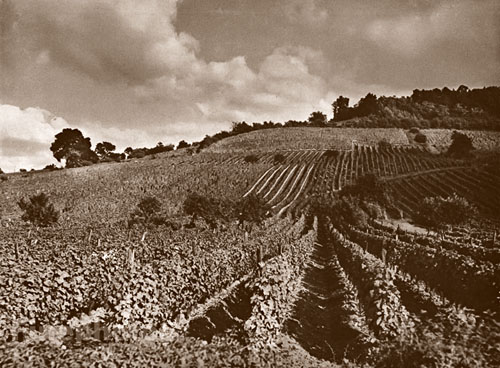
By this time you see the necessity of having a supply of young vines from a nursery, a circumstance that is by no means to be neglected.
In digging up the plants from your nursery, be careful to take them up without wounding or bruising the roots, and having a pail or small tub,
half full of rich dung water, put the plants, with the roots down, into that, so shall they be preserved from the Sun and drying winds, which would soon
parch and dry up these young tender roots and kill the vine. When you have dug up about a dozen or twenty plants, then proceed to planting,
which must be done in the following manner.
Planting.
Your holes being dug deep enough and sufficiently wide, for the roots to be spread it at full length, so high that the little branches
rise an inch or two above the surface of the ground. The roots, you will perceive, for the most part grow in rows, one above another.
The upper roots of all, which are called the day roots, must be cut away;
the under roots of all must then be spread at full length, and covered with earth, then the next must be served in the same manner,
and so on till all be regularly extended and covered. This is pursuing of nature, which in these cases is generally the best director. So
shall the earth be well settled about the roots, and the vines in the spring will grow and flourish, as if they had not
been moved or transplanted. If a servant, or even a gardener be left to manage this work, they will be apt,
as I have often seen, to set the plant in the hole, in a careless manner, with all the roots huddled together, and so
cover it with earth. This is so contrary to the order of nature, and to common sense, that the difference is plainly seen
without farther explanation; and indeed most of the miscarriages in life are owing to inattention and carelessness.
Your vines being all planted as above directed, and the vine cuttings, with one eye only above ground, and that almost
covered with light earth, to preserve them from suffering with heat and from drying winds 'till they begin to grow; this
upper bud only will shoot out branches, and the lower ones will throw out roots: And this is much
better than to have two or three buds above ground, and branches growing from them all, which only serve to
weaken the vine, and to hinder the forming of a good head, which is the first and chief point to be gained and
well secured.
Managing new cuttings.
We now proceed to the management of the vine in its infant state, upon which will very much depend the
success of your vineyard.
There are but two ways of forming and managing of vines to advantage for vineyards, by stakes, or espaliers.
In ancient times, it was common for vines to be wedded to trees, and they had the poplar, the ash, or the elm for their
companions and supports, but men soon discovered the the great inconveniency of following nature in this respect. They found, that these trees were found difficult to
raise in high dry grounds, where vines were proper to be planted; that when they did grow, their roots were very much in
the way of the vines, and of working the land, and also drew away too much of the strength of the ground; and
they mounted the fruit so high, that it became very difficult and took up a great deal of time to gather it,
for which reasons this method has long been laid aside. As for wall fruit, the vines that are fixed to walls must be
managed in the same manner, as those which are designed for espaliers, that is, the head of the vine is at first formed
about three feet from the ground. But this I shall particularly explain, when I treat of the management of vines
for espaliers. I shall begin then with the proper culture of vines that are designed for stakes.

In this case the head of the vine is formed near the surface of the ground, as I have already more than once observed;
and this method is now generally practised throughout wine countries, and indeed it is the only method proper for
countries, where the frosts in winter are so hard as to hurt vines, by which means the next year's crop is destroyed.
There is no way to prevent this, but by covering the vines in winter, which cannot well be done, when vines are fixed upon frames or espaliers,
without great difficulty and labour, as well as danger to the vine.
The first summer.
The first summer after the vine is planted, you have nothing to do, but to tie up the little branches to the stakes with a soft band, as
soon as they are grown about a foot or fifteen inches long, which will save them from being torn off by hard winds, which
would endanger the vine. Besides they grow the stronger and the better for it, and are out of the way of the hoe, the plough
and the harrow. You are also to keep the ground clean and free from weeds and grass; for they are great enemies to vines. If the
ground be kept mellow and loose, your vines will grow and flourish the better. If you have any litter, short straw
and chaff, the shives of broken hemp or flax, the chaff of flax seed, the dust and chaff of buckwheat, and the
straw trod fine with horses when it is dry, any or all of these spread over your vineyard after it is hoed or ploughed
and harrowed, will keep down the grass and weeds, keep the ground moist and light, and will greatly preserve the
good soil from washing away. If this be done the first three or four years, it will greatly forward the vines, bring
bring the ground into good heart, and finely prepare it to produce good crops, by keeping it loose, airy and light, in which vines greatly delight.
In the month of September, when the leaf begins to wither and fall off, which is the best time for trimming of vines, as I have already observed, cut down all
the branches, to one good bud each, and always remember that the lowermost bud next the old wood, is called the dead eye,
and is never reckoned among the good buds. When your vines are thus trimmed, let a careful hand take away the dirt
from the foot of the vine, about four inches down, and cut away all the upper roots that appear above that depth. These are called day roots,
and must be taken away every fall, the first three years. The best way is, not to cut them off close to the body of the vine,
but about a straw's breadth from it, so shall they not be so apt to grow again. These upper and day roots greatly weaken the vine, and hinder
the lower roots from extending themselves, and from firmly fixing themselves below, on which greatly depend the strength, firmness and
durableness of the vine, and also its fruitfulness. Besides by these roots running deep, the vine is preserved from perishing in long
tedious droughts. Let the foot of the vine be left open, after the day roots are cut away, that it may dry and harden, till the hard frosts come.
Then the holes are to be filled again, and the head of the vine covered with chaff and short straw mixed, or with bog hay, or salt hay,
or with horse litter, that is free from dung and grass seeds; for these should be carefully kept out of a vineyard, which will save the labour
of rooting out the grass that would spring from them.
Some cover the head of the vine with the ground when they fill up the holes;
but this is wrong, it greatly endangers the vine, as I have found by experience, for I have lost many of them by this management, before
I discovered the danger. The ground, in warm rains, moulds and rots the vine. For the same reason, suffer no dung to be among the straw, hay, or
horse litter with which you cover your vines. The heat of the dung, in warm rains or muggy warm weather, will mould and rot them;
the cooler and dryer they are kept, the better.
I have told you before, and I now repeat it, (because it is a work that must by no means be neglected,) when you trim your vines,
if you find that any of them have miscarried, which is very common, plant others in their room immediately, if you have any plants of the same
sort growing in your nursery; if not, then do not delay to provide cuttings of the same kind, and preserve them till spring, as you were
before directed, and plant them in the vacant places, that your vineyard may be full and complete as soon as possible, so that it grow and flourish
the better.
The second summer.
The second summer you will find more branches shooting from the heads of your vines, than did the first summer; and there the skill of a
Virgeron is necessary for forming the head of a vine in the best manner. Let the shoots grow, till they are ten or twelve inches long, then choose eight,
that are short jointed and much of a size, that grow on all sides of the vine, and with your finger strike off all the rest.
If any one branch among the whole number, appears much more thirsty than the rest, you may perhaps be tempted to save it; but let not your
eye spare it. It will only prove a thief and a robber. It will draw to itself the chief nourishment of the vine, and starve the rest of the
branches, and after all will bear but little fruit. The short jointed branches, prove the best bearers, and these
standing on all sides of the head, preserve the vine in full strength and vigor. For this reason the rounder the
head of the vine is formed, the better. If the branched be suffered to grow from one side of the head, the other side suffers greatly,
and is apt to perish.
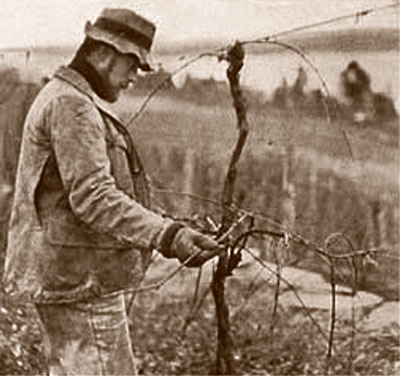
This year there should be two stakes to a vine, one of each side, to fasten the branches to, by this means they are spread at a distance
from each other, and grow the stronger and better; the Sun, air, and winds come to every part; the wood ripens well, and the buds fill, and they are the
better prepared to become fruitful in due time. Whereas, when they are huddled altogether, and fastened up to one stake,
they suffer greatly for want of the Sun and air to dry them after rains, mists and heavy dews; and in close muggy weather, they will mildew and rot.
Let therefore the branches be tied up singly to the stakes on each side, with a soft band, as soon as they are long enough, least
they be torn off by hard winds, which would ruin the vine. I need not tell you again, that your vineyard is always to be kept clean and free
from weeds and grass; and the dryer the ground is, and the hotter the weather, the more effectually they are destroyed, by hoeing, ploughing
and harrowing. But remember never to meddle with your ground when it is wet, you do more hurt than good.
This second summer your main branches should be suffered to grow about five feet long, and then the ends of them must be nipped off, in order to curb
them, to keep them within proper bounds, and to hinder them from growing wild. The lateral or secondary branches should be nipped off at the end, when they are
about a foot long, the nephews also should be nipped off when they are about six inches long. This is much better, than the taking all
these smaller branches clean away, which is the practice of some, who are more nice than wise. For I have found,
by experience, that, when these secondary branches are clean taken away, the main branches suffer; they grow flat, and appear distorted; which plainly shews, that nature
is deprived of something, that is essentially necessary to her well being. It is quite necessary to nip off the ends of the main branches,
when they are grown about five feet long. They grow the larger and stronger, the wood ripens the better, the lower buds are well filled, and
better prepared for the bearing of fruit. Besides it teaches the vines to become reconciled to a low and humble state, it curbs their pride and
ambition, which is always to climb and mount up above every thing that is near them, and educates them to bear fruit within your reach. Some time
after the tops of the main branches are nipped off, they will shoot out a second time, and then they grenerally throw out, from near
the end, two branches instead of one; so prone is the vine to shoot and extend itself, these also must be nipped off; at the same time the lateral or
secondary branches must be looked to and nipped off, if any of them are shooting out anew.
In the fall of the year, as soon as the leaf begins to wither and fall off, which happens earlier or later, according to the weather, cut
the branches down again to one good bud each, and take away the earth round the heads of the vines, as before directed, and cut away the day roots,
and manage them just in the same manner as you did the fall before. Now as some of your forward vines will bear fruit the third from
the planting, which is the next year, and as it is natural for you to desire fruit, and especially to know what sort of fruit, and how good,
your different vines will bear; to satisfy your curiosity, I would advise you to set aside two or three at most, of each sort of your most thriving
vines for that purpose, and instead of cutting down all their branches to one bud each, like the rest,
leave two ggood branches on each of these vines, with two or three good buds each, which will shew some fruit to your satisfaction. But be
persuaded to prevent the rest from bearing fruit till the fourth year, and the weaker vines till the fifth year,
and your vineyard will make you ample satisfaction, for this piece of self denial. For it greatly weakens a vine to bear fruit when so young;
and however fond most men may be of their vines bearing much fruit, the overbearing of vines is allowed on all hands, to hurt them greatly.
To prevent which, in wine countries, where it is common to lease out vineyards to husbandmen, whom they call Vignerons, they have very
strict laws, obliging them to leave four, six, or eight bearing branches on a vine, according to the age of the vineyard, the strength
of the vines, and the goodness of the soil, and according to the custom of different countries where good wines are held in repute,
to prevent their hurting the vines, and the reputation of their wines. These Vignerons are likewise obliged, after three fruitful years,
if so many happen successively, to let their vineyards rest one year without bearing fruit, that they may have time to recruit and gather fresh strength.
The third summer.
The third summer you are to manage your vines in the same manner you did the second, tying up all the branches to the stakes, one above another;
only of those vines that are to bear fruit, the fruit bearing branches should be tied up above the rest, that the fruit may have the
benefit of the Sun, the air and winds, all of which are necessary, and conspire to bring the fruit to maturity; and this
should always be the practice. This year a third stake is provided, which in the spring is drove down just on the north side of the vine, upon a line with
the rest, for order sake. To this stake the branches that bear fruit, there being but few of them, will be best fastened, because there will be the more
room for the branches of reserve, which are to bear fruit the next year, to be distinctly fastened to the side stakes. These
branches of reserve are now of great importance to the owner, as the next crop will depend upon the right management of them. They are,
therefore, to be carefully tied up at proper distances to the side stakes, that they may grow well, that the wood may ripen, and that the buds
may be well filled. When they are grown about five feet long, the ends must be nipped off, the lateral branches kept short, and the nephews restrained,
if they grow too long, so shall the main branches appear full and round, and in a natural, healthy and flourishing state; whereas, if
they are all tied up to one stake, as is the practice with some people, the wood remains green and spungy, and does not ripen, the buds do not fill well; and
where the band is, all the branches mildew and rot; which plainly shews the badness of such management. As to the few vines that bear fruit
this summer, let the fruit bearing branches be nipped off five joints above the fruit, and let the side branches and nephews be kept short
as above directed; so shall the fruit come to perfection.
In the fall of this third summer, preserve two of the best short jointed branches of reserve, one on each side of the head of the vine, for
bearing fruit the next year: The rest cut down to one good bud each. If some of your vines be very strong and flourishing, you may preserve four
branches for bearing fruit, but by no means more, one on each quarter of the fine, so shall they bear fruit the better. As to the
branches on the few vines, that bore fruit this year, they must be cut down to one good bud each; for the same branch must
never be suffered to bear fruit two years running, unless you fall short of branches of reserve, in that case you must do what
necessity requires, and let the old branch bear a second time, but they seldom or never bear so large clusters, nor so fair fruit.
On these vines, that bore fruit this year, not above two branches on each, should be kept for bearing fruit the next year,
so shall you preserve their strength from being exhausted when young; they will last the longer, and bear fruit the
more plentifully hereafter.
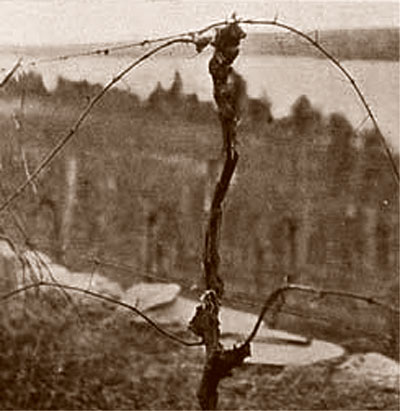
The rest of the management is the same with that of the last year; only some time in
the latter end of November, or somewhat later, if the hard weather keeps off, a small long trench on each side of the vine is dug with a hoe,
and the branches are are kept for bearing fruit, are laid down gently into them, without forcing them,
so as to crack them, or split the bark, or strain the wood too hard, and must be covered over with the earth.
If any part appears above ground, it must be well covered with straw, bog, or salt hay, and indeed if the whole that are buried were also covered
in the same manner, with straw, &c. it would be best; for the branches being of an elastic nature, they are very apt, upon the
thawing of the ground, to rise with their backs above the ground, and remain exposed to the weather, so that your
crop may be lost notwithstanding your trouble, which a small covering of straw or hay will prevent. If any of them should be so stiff and
stubborn as not to bend down, then bind straw round them and the stake.
The fourth summer.
In the spring of the fourth year, the branches that have been preserved for bearing fruit, must be carefully trained up to the side stakes,
the higher the better; and the branches that shoot out from the head this spring, which are called branches of reserve, and are designed to bear fruit the next
succeeding year, must be tied up to the stakes below the fruit bearing branches, and one or two to the middle stake, if there is room,
for often times the fruit bearing branches, occupy the middle as well as the side stakes, and
especially in a plentiful year. The management of the vine in its bearing state, calls for a close and particular attention.
Some gentlemen, and those who have written best upon this subject, recommend the taking away all the lateral or secondary branches
and the nephews, close to the body of the fruit bearing branch, and to leave only the main leaves of that branch, thinking, by this method, that all
the nourishment of the vine is thrown into the fruit. They also order the top of the branch to be taken off, within three joints of the
uppermost cluster of grapes. Others again are for following nature, and suffer all the branches to extend themselves as they will. These I look upon to
be, two extremes, and think that a middle way, is every way best, most rational and safest.
The lateral branches,
the leaves and nephews are supposed by naturalists to draw off and perspire the crude and thin juices and to hinder them from entering
and spoiling the fruit, and also serve as lungs for respiration; the circulation of the air through all the parts being necessary to
vegetation, and for bringing the fruit to perfect maturity. That this is so, or how it is, I am not so well acquainted with the operations of
nature, as to determine; but this I know, that when these smaller branches are taken clean away, the main branches instead of growing round,
full and plump, which is their natural state, become broad, flat and distorted, and have an unnatural appearance. Besides these branches, when
kept within proper bounds, serve to shade the fruit from the scorching rays of the Sun, and to screen them from violent winds, from hail and beating rains,
from damps and fogs and cold nights dews, which are all injurious to the fruit, as well as the cold dry north-east winds, and the cold
driving north-east storms. But let not this lead us into the other extreme, for if the vine be left to herself, and all be
suffered to grow, she will run wild, and ruin all by her own excess. This is the method of managing vines when the head is formed
near the ground, which is now practiced in most vine countries in vineyards, (except some parts of France, where they are still fond of espaliers.)
and this method must be continued as long as the vines last, which most writers do affirm, will be above a hundred years.
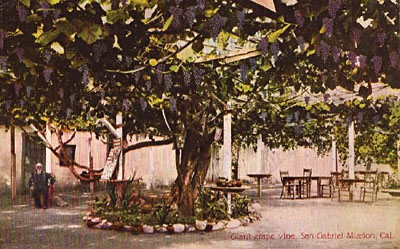
As to the management of vines in gardens, against walls, and for forming of shady places, and many other ways to please the humour and phantasy of the
owner, that is not to be regarded, it has no relation to vineyards.
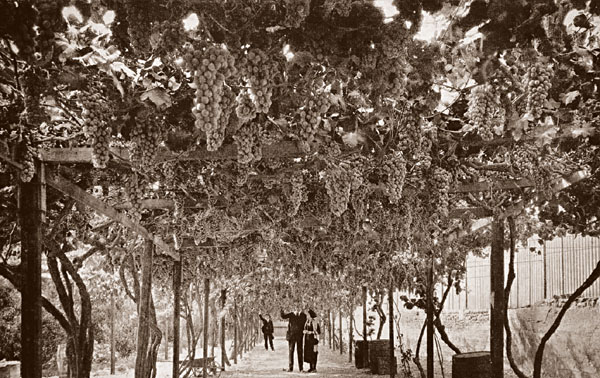
Here I would propose a new method of managing vines, the heads of which are formed near the ground, by way of trial; I have not yet made the experiment,
if it should answer, it would save a good deal of trouble, and be more secure against the severities of the weather; I have been told that it is
the practice of some to cut all the
branches down, and to trust to new shoots for bearing of fruit; and I have read the same account in a treatise published by
James Mortimer, Esq; fellow of the royal society, in the year 1707, but these accounts are so vague, so general and superficial,
without entering minutely into any particulars, that I could have no dependence upon them; nor could any man form a judgment of the manner of doing it.
However from thence I have taken the hint, and shall now propose a method which may be worthy on trial.
If the fall of the third year
of the vine's age, instead of favoring two or four branches for bearing fruit, cut down these to two buds each, and the rest cut down to one bud each;
the upper buds of these branches that have two buds, are designed to bear fruit, this next year, the lower buds and the buds of all the rest
are designed for fruit the year after, and therefore if any fruit should appear upon them, they must be taken away as soon as the clusters appear; in the
fall of the fourth year, cut all the branches that have born fruit clean away, and leave those that did not bear fruit;
and then according to the strength of the vine, cut as many of these down to two buds, as you think your vine ought to bear, and cut the rest down
to one bud, always remembering that the branches that have but one bud, and the under bud of those that have two, are to bear no fruit. When
your vines come to be strong and able to bear it, cut down all the branches to two buds, and then you will have eight bearing branches in one year, which
is quite enough for the strongest vines; however if you have a mind to strain your vines, and to try how much they will bear, you may then
cut as many branches as you think fit down to three buds, two of which may bear fruit, while the under buds are kept for branches of reserve. In the fall,
all the fruit bearing branches are cut clean away.
If this method should succeed to your mind, and you think it preferable to the method first laid down,
I mean that of preserving branches of reserve to be laid down and covered in winter, which is the German method, and the general practice of the Rhine, &c. then in order
to bring your older vines into this method, cut down the fruit bearing branches to one bud the first year, and the branches of reserve you may
cut down to two or three buds each, as you think your vines are able to bear it. In this you form your judgment, from the strength of your vine,
the goodness of your soil, the distance of your vines from one another, and the quantity of fruit they have born the three preceeding years: for
vines, as well as men, must have time to rest and recruit, if you mean them to last, and to return to their work with vigour.
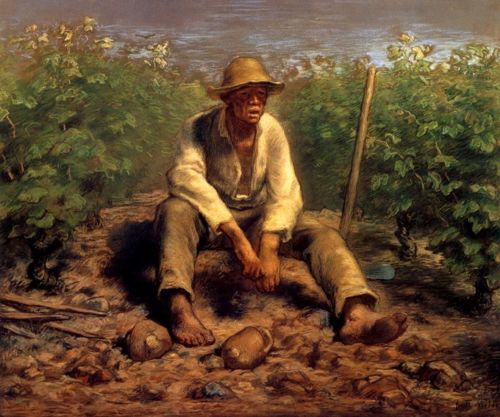
Now for the covering of these vines in the winter season, I would advise a handful of soft hay, that is free from grass-seeds, to be laid on the head of the vine,
and a slight box made of rough cedar boards, or of pine, (which any servant may make, only let the top piece cover the whole,) be put over the head, which will be a safe
and sufficient covering. Otherwise a small sheaf of straw, bound well round the stake, and the bottom brought handsomely all round the head of the vine,
and secured by a band from blowing open, will do very well. The vines should not be covered till hard weather is ready to set in, and they should be dry when
covered.
General pruning issues.
Before I proceed to the management of vines for the frame or espalier, it will be necessary to acquaint you with some things of a general nature,
which you will find worthy of notice.
When vines are trimmed in the fall, which they ought to be as soon as the vintage is over, or as soon as the leaf withers and falls off, they
seldom bleed, and never so as to hurt them. If vines have been neglected and not trimmed in the fall, and this work must be done in the spring,
let it be done in February, if good weather happens, or early in March. If it be done later, they will bleed too much,
and endanger the crop. Searing the wound, as soon as it is made, with a hot iron, it is said, and I think with reason, will prevent the bleeding.
In trimming, keep about two inches from the bud, or half way between bud and bud: so shall the upper bud that is left be free from danger.
The rule is, to cut sloping upward, on the opposite side to the bud, that the slope may carry off the tears from the eye,
but I never found this any kind of security to the eyes below. If therefore searing every wound with a hot iron be thought too much trouble, the only remeedy,
besides that, which I have yet been able to discover, is, to wash the branches that are wounded and bleed, and especially the buds, with a rag dipped
in warm water, without touching the wound, which in 8 or 10 days will stop of itself; the liquor forming a stiff jelly upon the wound, like
coagulated blood, and drying by degrees, heals up the wound. The washing must be deferred till they have done bleeding. Unless this is done, the
eyes below will be in danger of being blinded. For so glutinous is the sap, that it binds up the bud it reaches, so that the leaves cannot open
and unfold at the time of vegetation. In cutting off large limbs from old vines, it sometimes happens that ants fall upon the pith,
eat their way in, and make a hollow, where the water settles and rots it. In this case the remedy is, to cut such branches close down to where
it is solid and green, and it will bark over and heal.
It is common for large buds to shoot out two or three branches each. One only on each should be suffered to grow; if you expect fruit on them,
be not in a hurry to strike them off 'till you know which is most fruitful, and save that. Vines that are close planted in a vineyard, cannot
be expected to bear so much fruit, as single vines, or as those that are planted at a distance. Their roots are too much confined, so that they cannot
gather nourishment in so small a compass of ground, to support and bring to perfection a large quantity of fruit; and this is a sufficient
reason for restraining them, and for limiting the number of bearing branches, if you mean to make good wine, to keep your vines in full vigour
and to preserve them for many years. Besides the deficiency is fully made up, byu a greater number of vines; and the planting them close,
enables you the better to keep them low and within proper bounds.
Vines that bear black or red grapes generally shoot forth a greater number of branches, and more vigorous than those that bear white grapes, and therefore
the latter require more caution in trimming, and more care in the cultivation and management of the soil, that it be kept clean and in good heart.
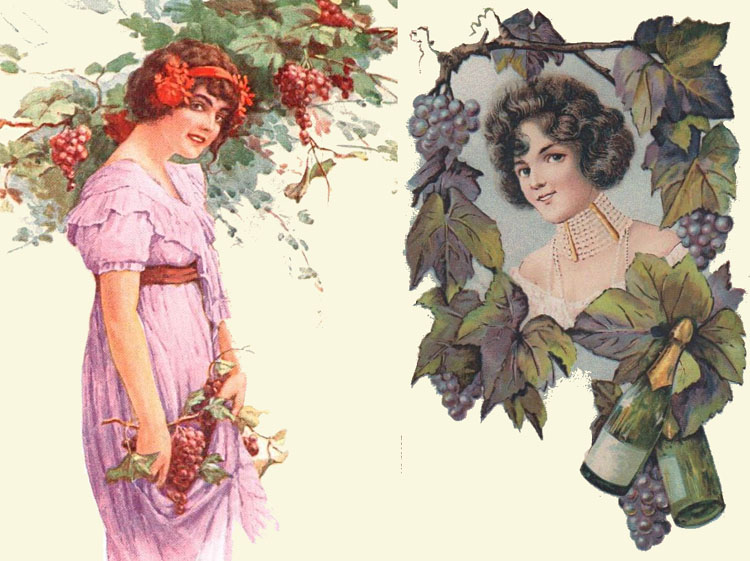
When vines have been covered with earth during the winter season, let them not be uncovered in the spring, till the hard frosts are over, and then let it be
done in a fair, warm, drying day, that they may dry before night, for if they should freeze before they are dry, it would greatly hurt, if not ruin the crop.
The head of the vine, properly speaking, when it is formed near the ground, is composed of the but ends of the branches,
that are cut down to one good bud each, which ought to be eight at least in number. These branches, the second year of the vine's growth, shoot from
the solid wood chiefly, and then is the critical time to prepare for forming a proper head to a vine; therefore preserve eight of the best short
jointed branches, that grow on all sides of the flock, and much of a size, and these must be carefully tied up singly to the stakes, that the
buds must be carefully tied up singly to the stakes, that the buds may fill well, and that the wood may ripen, on which greatly depends the
future success of your vineyard, as this is the foundation of the whole. If more than eight branches have grown from the head, the rest must be
struck off with the finger. If one of the branches outgrows the rest and appears more flourishing, that in particular must be struck off.
For if suffered to grow, it will rob the rest of their due proportion of nourishment, and ruin the vine. Eight branches are sufficient for
a thrifty young vine, four of which are intended for bearing fruit, when that time comes, and the other four are designed for branches of
reserve. The third year, which is the first year of the vine's bearing, the lowermost good bud on the bearing branches, will produce one or two
clusters of grapes each. The fourth year, two or three of the lowermost buds will bear fruit, and after that five or six of the lower buds
will bear fruit, but seldom more; so shall you have five or six branches, growing from each bearing branch, producing fruit, which
makes twenty or four and twenty bearing branches upon one vine, and each of these branches yielding two, three or more clusters,
according to the fruitfulness of the year, and the due cultivation of your vineyard.
Nay if your vines are well chosen, as I have directed, and properly cultivated, and your soil kept clean and well improved, you shall, in a fruitful year,
see some of the secondary branches and even the tendrils bearing fruit. This happened to some of my vines in the year 1767. I had
four successive crops hanging on several of my vines at one and the same time, one under another, which I shewed to several gentlemen, who admired,
and were surprized at such a production: But I took away all but the first crop, least my vines might be too much weakened by over bearing.
I mention this to shew what nature will do in a favourable year, under proper management. And here I must remark, that the greater the vintage,
the better the wine, but a meagre thin crop produces thin weak wines, which require dexterity and art to make them fit for use; but this
I shall instruct you in, when I come to the making of wine.
General vine management issues.
In transplanting vines or trees of any kind, I have by long experience found, that removing them in the fall, after the leaf is fallen, is much surer
and safer, than doing it in the spring. For if trees are well staked, so as to stand firm against hard winds, the ground will be so well
packed about the roots, that they will grow in the spring, as if they had not been removed, and are in no danger, if a dry season should happen,
especially if some horse litter or old hay be thrown round them in the spring, so as not to touch the stem. Whereas if they are removed in
the spring, and a drough succeeds, before the ground be well settled about the roots, many of them will miscarry.
As vines are best planted upon rising grounds to prevent too much wet, and as it is necessary to keep the soil loose and mellow, it thereby becomes
the more liable to washing away by hard rains, which must be a great injury to a vineyard; now if by any means so great an inconveniency
might be avoided, it would be a great point gained, and therefore it very well deserves our attention: For it is no small cost
and labour to renew the soil, that is sometimes carried off by sudden floods of rain. I have tried several ways to prevent this evil, so as neither
to injure the vines, nor hurt the crop. The following method, where a person has the conveniency, I find to be the most effectual.
Lay broad flat stones, not exceeding two inches in thickness, close along the lower side of the vines, after the ground has been made loose and mellow. These
stones being broad, and not very heavy, do not press hard upon the roots of the vines, nor pack the ground too close. They reflect great
heat up to the vine and fruit, which helps to bring it to full maturity; they preserve the soil from washing away, they keep the ground
moist in the driest times, and hinder too much wet from penetrating down to the roots near the head of the vine, which chiefly occasions the
bursting of the grapes when they are near ripe, after a shower of rain. To prevent this evil, is one reason for cutting away the day roots, which
extend themselves along near the surface of the ground. But where such flat stones are not easy to be had, I would recommend short
straw mixed with chaff, the shives of flax and hemp, the chaff of flax-seed, which is also an excellent manure, old half rotted salt hay,
or bog hay, free from grass seeds, spread thin between the rows; if it be spread thick, it keeps the ground too long wet and cold in the spring,
which retards or keeps back the growth of the vines. These I have experienced to be profitable, and very much to hinder the soil from
washing away. On the side of steep grounds, of hills and mountains, stones in proportion to the descent, or logs of wood, where stones
are not to be had, must be laid along the lower side of the vines to keep the soil from washing away, which otherwise it will do, to the great damage, if
not the ruin of your vineyard, and therefore when you begin a vineyard, remember that this is one, and an essential part of the cost.
A vineyard will thrive the better and the crops will be more sure, if it be well screened, by some good fence, buildings, mountain, or thick
corpse of wood at a small distance, from those points that lie to the north of the east, and to the north of the north-west; the winds from those
quarters, in the spring of the year, being very unfriendly to vines. But then a vineyard should be quite open to all the other points of the compass.
For vines delight much in an open, clear, pure warm air, free from cold damps, fogs, mists, and from condensed air, arising from bogs,
swamps, and wet clay grounds, and from large tracts of neighbouring woods. The north-west winds, indeed are rather advantageous
to a vineyard: For although in America, they are extremely cold in winter, and occasion severe frosts, yet as the vines are then covered, they do
them no harm. Besides those winds are generally drying and seldom bring wet; in the spring and summer they are always cool, and I find by
long experience that they are quite necessary, to brace up, harden and confirm the leaves and tender new shot branches of all trees and
vegetables, which otherwise remain languid and weak.
There are three seasons when careful and experienced vignerons deny access to their vineyards, first when the ground is wet, because then the weight of a man presses
down and packs the earth too close and hard upon the roots of the vines. Secondly, when the vines are in blossom, because if they are then disturbed
by handling, shaking or rubbing against them, the farina or fine dust that is formed on the blossom, which impregnantes or gives life to the fruit,
is shaken off and the fruit miscarries. Thirdly, when the fruit grows ripe, because the temptation is too strong to withstand, and people
will pluck off the fairest ripest grapes, which vignerons do say is an injury to the whole bunch; be that as it may, it certainly is a great
injury to the owner, for the fairest ripest grapes make the richest and finest flavoured wines.
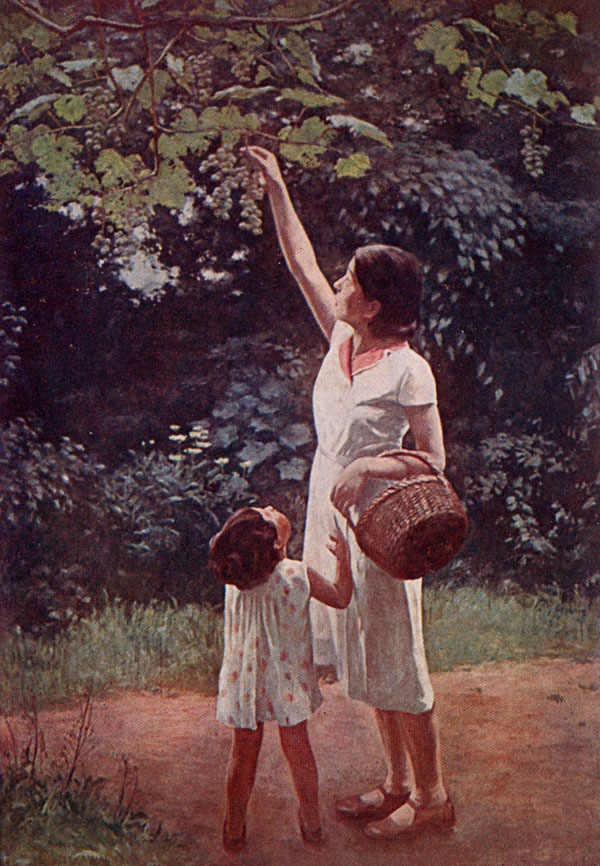
Management of vines upon espaliers.
I now pass on the management of vines upon espaliers: But then you are to remember that, the training up of vines to these frames, is only
fit for the southern or warmer climates, where the winter frosts are not so severe, as in our more northern regions; for as they are to stand
exposed to all wethers, the germ or bud, from which the grapes do spring, are apt to be chilled and destroyed by the severity of a sharp season,
and especially by moist sticking snows freezing hard on the branches.
The first year the young vines are trimmed and managed in the same manner you have been before directed.
The second summer.
The second year when they always shoot forth a greater number of branches, is the time for making choice of the best branches for standards.
Set apart, therefore, two of the best short jointed branches, on each vine, for that purpose, that you may be secure of one,
in case the other should fail, as these branches when young, are subject to many accidents: So shall you stand a fair chance of having
fruitful vines; for all vignerons well know, that vines shoot forth more barren and unfruitful branches, then fruitful ones, therefore,
as experience hath taught them, they always set apart short jointed branches for bearers, because these seldom fail yielding much fruit; all the rest
of the branches you strike off with your finger: Again, would you still more effectually avoid barren vines, if you
have it in your power, choose your vine cuttings for planting, from fruitful vines; not only so, but choose fruit bearing branches,
that grow from the teeming part of the vine, that is as near the head and shoulders as possible, and then if you
cultivate them well, you shall be sure of having fruitful vines; and this, let me tell you, is gaining a very grand and essential point:
I have here repeated this instruction, that you may not neglect it, nor miss of so great an advantage.
Having thus chosen two branches for standards, train them up as straight as you can, one on each side of the stake: When they are grown about fifteen inches long,
bind them gently with a soft band to the stake; for they are then yet very tender: And as they grow longer bind them a second and a third time; and when
they are grown up to the top of the stake, which must be five feet high, nip off the ends, and they will grow the thicker and stronger. When
you have taken away the tops of the vine she will try to recover herself, and will shoot out two branches at the top instead of one; but
these you must also nip off, and keep short, but take away none of the lateral branches or nephews till you come to trim them in the fall, only nip
them off, to keep them within proper bounds. In the fall when the vine leaves begin to wither and fall, cut away one of these standards from each
vine, close to the stock, leaving such as you best like, which is now out of danger, and trim away from her all the branches and nephews, and
cut off her top within three feet and a half of the ground; leave four buds at the top, and cut off the ends of the buds below them;
all these wounds will be healed before the hard weather comes on, which should not be over severe where espaliers are used; the two upper
buds will be the arms of the vine, the two lower buds will be the two shoulders, and just under these the vine is fastened to the espaliers,
and is called the head of the vine.
Now it requires the greatest skill of the most experienced vigneron to manage and cultivate vines thus educated and trained
up to espaliers; and therefore they are more fit for gentlemen's gardens and the vineyards of rich men, who can afford the expense of these frames, and to
employ vignerons to manage vines in this manner, in order to obtain the richest wines, than for common men and men of small fortunes,
who must chiefly manage these affairs with their own hands, and for whose sakes I have taken the pains to write this treatise; but that I may do
honor to the rich and great, and shew them that respect, which I think due to their distinctions and high sstations. I will proceed and give such
instructions as shall answer their expectations; but then I must leave to guard them against pretenders to this art, for there are pedants, and
not a few, among vine dressers, as well as among men of letters. The greatest difficulty, as experienced vignerons know,
is so to manage a vine, as to keep her within the height and compass of a frame, and yet to cause her to bear fruit plentifully.
The third summer.
The third summer the espaliers being regularly set up six feet high, in a line with the vines, the posts being of some lasting wood as of red cedar,
locust or of mulberry, which are cheapest in the end, or for want of these, of good thrifty chestnut, that is not worm eaten; and
being firmly fixed in the ground, in the middle space between vine and vine, and the rails, being four in height, well nailed to the posts,
and placed on the north side of the vines, the lowermost about three feet from the ground, or just below the lowermost bud on the vine,
the vine must be fastened with a soft yet strong band to a stake firmly fixed down near the foot of the vine, and fastened to the frame,
near the lower rail, the four buds rising about it. When these buds shoot forth their branches, they must be regularly trained up to the
rails above, and fastened to them with a soft band; as soon as they are long enough to reach the first above them, they must be fastened to that,
and so to the next, &c. as they grow; and this must be done by a careful hand, because these branched, at first, are very tender;
if they should be neglected, till they are grown longer before they are tied, they will be in great danger of being torn off by hard winds, to the great
damage of the vine. When the branches are grown up to the top of the frame, the ends must be nipped off even with it, and when from the
tops they shoot forth again, they must again be nipped off and kept down even with the frame, and this not so much for beauty and order sake,
but that they may be properly educated and taught to be humble and keep within the limits assigned them. The later branches and nephews also must be kept
within proper bounds and not suffered to grow too long, for some of these side branches will steal away to a great length, and rob the vine of
her strength. If any fruit should appear this third year, which may happen, let it be taken away, as soon as it appears, and your self-denial
shall be amply rewarded the succeeding year; For it greatly weakens a vine to bear fruit so young. Besides not only the durabeness, but
the fruitfulness of vines, very much depends upon the proper culture of them when young.
In the fall of this third year, the lateral branches and nephews must be carefully cut away from the main branches, so as not to hurt,
or rub against the lower buds, with the back of the knife, which is frequently done, by cutting off the branches too near the germ or bud.
For if the thin bark, that covers the bud, be rubbed off, under which is a soft warm garment of cotton, to preserve it from violent colds,
the wet gets in, freezes and destroys the germ. The four main branches, that sprung from the four buds, must now be cut down to two good buds each;
the lower bud, next the old wood is never looked upon as a good bud, it is called a dead eye, or barren bud; because it bears no fruit, at least
not the first year of its growth: And yet notwithstanding you will be obliged sometimes to make use of it, as I shall presently shew.
In cutting off the main branches, cut slanting upward, so that the wound appears in the shape of the nail of a man's finger, and let the slope be on
the opposite side of the bud, that if it should weep, the tears may drop free of the bud; this is the rule, but I have given my opinion on
this precept before, to which I refer you. In cutting, approach not too near the bud, that is left, but keep at two inches distance from it,
least you endanger it, by letting in the cold air and wet upon it, before the wound can heal.
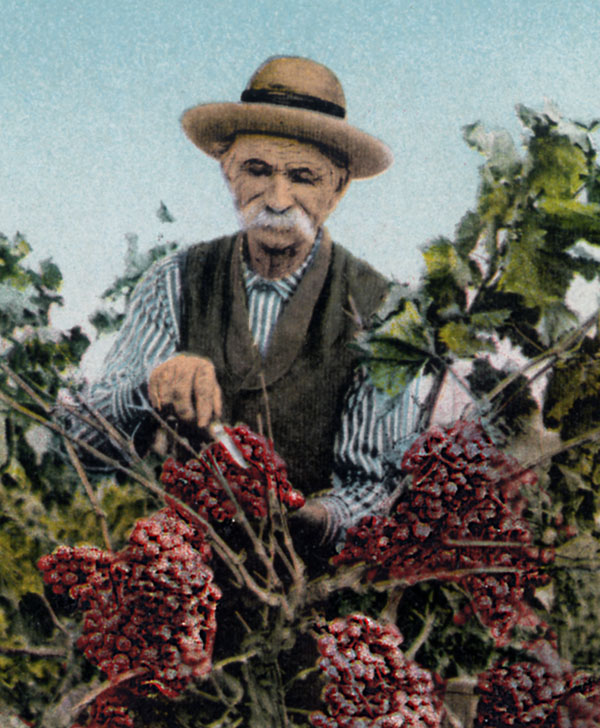
The chief point, in managing these vines, is, the providing branches of reserve for recruiting the arms in such manner, as to confine the vine within the
compass of your frame; for if you raise new arms from the old ones, your vine will soon outshoot the frame. You must, therefore, seek for new arms from the soulders:
If a branch grows in a proper place, any where between the arms and the head, and happens to be broken, clip it into a thumb, that is, cut it down to two
or three good buds, as soon as you discover it, and this is called a keeper, and very well supports the place of a branch of reserve. Sometimes you
will be glad to make use of the half starved branch, that springs from the dead eye beforementioned; nay sometimes you are drove to the necessity of nursing
up a small bud of two leaves, or a knob or wart for that purpose; and when none of these are to be found, you must wound the vine
in a proper place, somwhere about the shoulders, with a bodkin or sharp pointed instrument, in two or three places, from which it is usual for a branch
to shoot, if it be done sometime in the spring: But if all should fail, you then will be obliged to raise your frame higher, and make use of some of the
branches, that grow out of the arms, the nearer to the shoulders, the better: But if you have been drove to this necessity before, and your frame has been already
raised to a sufficient height, there then remains no remedy but a desperate one, since the disease is become desperate, that is, to cut such vines down
even with the ground, and from these stumps fresh shoots will spring and bear some fruit, the second year after, if a proper choice be made:
They must be cut when you trim your vines.
If any fruit should appear on any of the branches, that grow from the shoulders, which is often the case, let them be taken away as soon as they appear,
for these being branches of reserve, they are designed to bear fruit the succeeding year, the arms only are to bear fruit the present year: These directions
will serve for the fourth, fifth, and the succedding years.
In the fall of this third year, I have above directed you to cut the four main branches that grew from the four buds, down to gwo good buds each,
but this is designed for the strong vines only; those that are weak, must be cut down to one good bud, each branch, so shall they flourish and
gather strength the better, and if any fruit should appear on the weak vines the fourth or even the fifth year, strike them off as soon
as they appear, and they will afterwards make you ample satisfaction for this prudent management of them when young and weak;
and once for all be persuaded not to overload young vines with fruit; if from a fondness to outdo your neighbour, you run into this error,
your vines will pine and be at a stand, and will not recover for some years; and then your neighbour, who has cultivated his vines with more prudence
and caution, will triumph in his turn, with greater reason, and with much greater advantages.
The fourth summer.
The fourth year when you trim your vines in the fall, you may cut the arms down to one good bud each, instead of taking them clean away,
for the vines being yet young and low, these two buds will in a manner become part of the shoulders, being so near them; these will bear fruit the next,
which is the fifth year; and then you can save the two lower buds, that grew on the branches that sprung from the shoulder, for branches of reserve,
by taking away the fruit as soon as they appear, and these will bear fruit the year after; so shall you have four branches bearing fruit the fifth year,
which is quite sufficient.

The sixth year you may have three good buds on each branch for bearing fruit, and the seventh year you may have four buds on each branch,
which will make 8 bearing branches, which are thought by the best judges to be quite sufficient for the strongest vines, if you mean to make
good wine; and to this number vignerons are generally confied.
Vines that are designed for espaliers, must be planed further asunder than those, that are intended for stakes; for as they rise much higher with
the stem, they require more nourishment, and more room to extend their roots; ten feet is by no means too much: twelve would be better;
Suetonius, a learned man, well known to men of letters, made this remark as he traveled through the wine countries, that the farther vines were
planted from each other, the better he found the wine.
One general rule is necessary to be laid down, in order to give young vine-dressers, a clear idea of the nature and manner of trimming vines,
which is very apt to puzzle young beginners; know then, that the young wood that grew this year, must be preserved for bearing fruit the next year,
and those branches that did not bear fruit, are better for the purpose than those that did bear fruit; and for this reason,
you are directed to strike off, with your finger, the young clusters, as soon as they appear, from those branches, which you reserve for bearing
fruit the succeeding year. When I mention a branch, I mean a main branch of young wood, not a side or lateral branch, that grows upon these young main branches.
When the arms have born fruit, they are cut clean away in the fall of the year, as soon as the vintage is over, provided you have branches of reserve,
growing on the shoulders to supply their places: But if you have been so unlucky, as to have failed in these, notwithstanding all your attempts
to procure them; you must then do what necessity requires, and cut the arms down to two, three, or four good guds each, according to the
strength of the vine; but then remember, not to suffer any fruit to grow on the branches, that spring from the lower bud on each old arm,
these being now absolutely necessary for branches of reserve, in order to recruit the arms the next year. According to these rules
you constantly proceed with vines on espaliers.
Issues for southern vineyards.
As some of our southern colonies have a hot sandy soil, and are subject to great heats and parching droughts, and
thereby find it very difficult to raise and preserve vines, so as to become fruitful; I shall here offer some thoughts and directions,
which I imagine most likely to succeed in these parching hot countries; as I most sincerely wish comfort and
happiness to every colony on the continent and that the whole may become as beneficial as possoble to the mother country.
First then, I think it necessary to shade the young vines the first two or three yars, during the hot dry seasons, by driving down
firmly in the ground, branches of tree thick set with leaves, on the fourth side of the vines; these are better than matts, or pieces of
thatch work, as the air and winds can pass more freely through them; it will also be necessary to water these young vines twice a week,
during the hot dry seasons, in the evening, that the water may have the whole night to soak down to the roots of the vines,
to cool and refresh them; the branches, in these hot countries, should not be tied up to stakes, but should be suffered to run on the
the ground to shade keep it moist and cool. These vines must be trimmed in the same manner, as those which are designed for stakes, as soon as
the leaf falls, or the vintage is over. The third year instead of driving stakes down to fasten up the branches to them, let short croches
be drove down about six feet asunder, and pretty strong poles laid across upon them, so that they may lie about fourteen inches from
the ground, and so near to each other, that the branches of the vines may be conveniently run upon the poles without dipping
down and running upon the ground; if the ends of the vines should run beyond the sides of this bed of poles, they must be turned in and
confined to their proper bed; because it will be necessary to have a walk or path of two feet wide between bed and bed to regulate the
vines, to cut away the luxuriant suckers, that rob the vine and the bearing branches of their due nourishment, to gather
in the vintage, and to trim the vines.
This bed of poles should be so placed, as to extend three feet on each side of the row of vines, so that the rows
of vines standing eight feet asunder, there will be a path of two feet between row and row for the necessary purposes
before-mentioned. Particular care must be taken, not to take away too many branches from these vines, unless there should happen an uncommon wet season,
nor to keep them too short, because they are designed to shade the ground as much as possible, in order to keep it cool and moist,
which is necessary for the growth of the vine, and for bringing the fruit to perfection; but then in the beginning of August,
or about a month before the different sorts of fruits begin to grow ripe, each in their proper times, you should take away the lateral branches
and cut off the tops of the main branches, but this must be done, not all at once, but by degrees, some now, some then, and
that according to the dryness or wetness of the season, for this must be done to let the Sun and the air, which, at this season of the year,
become necessary to bring the fruit to perfect maturity; the wetter the season, at this latter part of the summer, the more branches
must be taken away and the shorter the main branches must be cut, and if necessary most of the leaves must also be plucked off; the fruit
will ripen the better, and make the richer wine, and all this may be done without any injury to the vines.
Here I would observe that the same management with regard to the thining the branches and the leaves at this season of the year,
is necessary for vines that are fastened to stakes or espaliers, in order to meliorate and hasten on the full ripness of the fruit; and
remember that the longer white grapes hang on the vines, even after they are ripe, if the season be dry, the richer wine they make. But it is
otherwise with the black grapes; when they are full ripe, they must be gathered and made up into wine, if not, they rot and dry away
suddenly, and perish in less than a week.
Portuguese Vine Management
The Portuguese form the head of the vine year the ground, but whether through carelessness, the love of ease, or the wanter of proper
materials, I cannot determine, but they have a method peculiar to themselves of managing their vines; they drive crotches into the ground,
upon which they fix strong poles, which lie about three feet from the ground, some more some less, according to the steepness of the hill,
for their vineyards generally grow upon the sides of hills and mountains. The branches of the vines, when grown long enough, they
throw over the poles and fasten them; they trim them and nip off the ends of the branches according to art, and in the beginning
of autumn, they cut away the lateral branches and nephews at different times and by degrees pluck away all
superfluous leaves, so that the fruit becomes much exposed to the sun, the air and winds, that they may arrive at full maturity.
They then gather them, take away all the rotten and unripe fruit, throw them into the vat and tread them lustily, singing all the while some
Bachanalian songs, according to the Portuguese dullness; and when they are sufficiently trod, they take them out and press them as dry
as they can; they then turn the husks into the vat a second time, and although they appear quite dry, yet they trample them over so long
that the very husks seem to dissolve into wine, this they press a second time, and this is laid by for the richest Madeira wine;
which in other countries is dashed with water and made into a thin wine for common use.
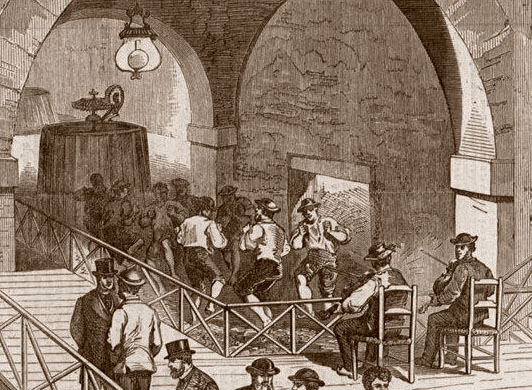
Soils and Dungs
If you mean to have plenty of grapes, your vineyard must be well dunged every three years, but hot dung must not be thrown near the stock of the vine;
poor people who cannot come at so great a quantity of dung at a time, may dung one thing of their vineyard every year; I shall now take
notice of the different soils and dungs that are best and fit for vineyards; a vineyard planted on a piece of good strong new ground
needs no dung the first seven years. The best manure for a vineyard is such as is warm and free from grass seeds, for grass is a great
enemy to vines; Fowl's dung of every kind, except water fowl;

soap ashes, or other ashes sprinkled thinly between the rows of vines,
but not too near them, for this manure is very hot and sharp, and is best spread on the ground in the fall, that it may mix with the soil and be
properly tempered before the heat of the next summer comes on, otherwise it would burn up the plants the rich soil that is
washed down and settles along the sides of brooks and rivers and in many low places along roads and highways, which poor and industrious
people may easily come at; sea sand, mixed with common soil that might be taken up along the high ways, would make an excellent manure;
in short, sand of every kind mixed in large proportions with good soil, is very comforting to vines, for those vines produce the sweetest
and richest grapes, and the strongest and best flavoured wines, that grow in rich sandy soils: The morter of old buildings, that has been made
of lime and sand, pounded fine; the dust of charcoal, the small coal and the earth that the coal kilns are covered with when burnt;
the soot of chimneys; the small cinders and black dirt found about smith's shops, all these are excellent manure for loomy or clay grounds
to warm, to open and to dry them, and especially if a large quantity of sand, be mixed with it; creek mud, or the mud along the sides of
rivers thrown on in the fall, or thrown up and sweetened all winter and laid on in the spring, is a rich manure for sandy lands, or for clay and loomy lands
if mixed with a good quantity of sand. All warm rich untried earth is excellent, so is street dirt of cities.
Come we now to what may be for the most part in every farmer's power to procure: And first it will be proper at certain seasons of the year,
when the grass is free from seeds to pen his cattle and sheep in some convenient place, where the dung will not wash away, and as near
to his vineyard or house as may be; into this pen let him throw his straw of all kinds, that is free from grass seeds, his buckwheat straw,
chaff and dust, his old salt hay or bog hay; if he lives near to marshes or salt meadows, let him cut good store of reed, when it is near ripe, thatch,
course three square and sedge, let it be dried and brought into the pen; then let him get rich black soil, that settles in low places and the
bottom of ponds, that are dry or partly dry in summer, and what settles along the sides of brooks and rivers, and throw these in, let him get good store of leaves of every kind, and
throw all the soap suds, chamberlye, the blood of beasts, pork and beef pickle, cyder and beer emptyings, and greesy dish-water, the water that
salt meat has been boiled in all these contribute greatly to make very rich manure.
The next best method for making good store of manure is to throw most or all of the above materials into a pretty large hog pen;
(if the hogs are fed with red clever, cut green, when it is about two thirds grown, and so on till the seed be grown but not ripe,
this mowed twice or three times a day, and given to the hogs is an easy and cheap way of feeding them, and will make a rich manure,) hogs
will champ with their mouths and trample with their sharp pointed hoofs these materials, and make them fine in a short time, and by rooting, will so tumble and
mix them together, that they will soon rot and make good store of manure. Then again, if corn stalks, husks and cobs, such as the cattle do not eat,
be thrown into a hollow place, where they may be wet, also the chaff of flaxseed, the shives and hurls of flax and hemp, where they will rot
in a year's time, these make a good manure.
The benefits of a four year crop rotation.
Here let me remark, without giving offence to my dear countrymen, whose good I have always studied, and whose interest I would willingly
promote, that with a little more industry and application, and some easy and proper contrivances, take the whole country in general, I am pretty
certain, that ten times the manure might be made and saved, that is made at present, and how much our old lands stand in need of it; every farmer
very well knows; and give me leave farther to assert, that where a man has it in his power, and can employ a hand and team altogether in cutting and
bringing together as many of the above materials, as can conveniently be had, at the year's end, he would find him by much the most profitable employed
of any man and team upon his plantation: For I am clearly of opinion that, ten acres of land well manured, will produce a much greater
profit to the owner than forty acres of common old lands as they are now managed; the whole charge of manuring, tilling, and of the seed for sowing,
together with the fencing, reaping, threshing, &c. being fairly calculated. For the ten acres will produce four good crops successively,
one of barley, then one of wheat, the next of oats, and the last of rye; and with a sprinkling of dung, it may be laid down with red clove:
The charge of ploughing for these four crops, amounts to no more than the charge for ploughing the forty acres for one crop, the expence of fencing the
latter is much greater: The forty acres in the common way of working, lies fallow for three summers, and generally yields but very little grass, the
fourth summer it is ploughed again and yields no grass at all; whereas on the plan proposed, the ten acres in the fall after the wheat and the rye will
yield plenty of grass. Pardon this digression, I hope it will not be altogether unprofitable.
Guarding grapes during growth against theft and spoilage.
Grapes are delicious fruit and very tempting to people of every age and sex, the rude and unthinking sort will take all advantages of your absence or
neglect at the time of the fruit's beginning to grow ripe, to rob and pilfer; such therefore must be carefully guarded against, by a good
close high fence without, and a smart watchful dog within, and especially by the vigneron's appearing now and then with a gun in his hand
walking about his vineyard in an evening, particularly when there are idle people without; this will effectually prevent any attempts, when they
see what they apprehend to be so very dangerous.

But these are not the only enemies we have to fear and guard against, there are others which appear less formidable, and yet are full as destructive,
namely birds: The robins are very numerous, and devour abundance of grapes; the best and most effectual method I ever discovered to get
rid of these, was to destroy their food, that ripens about the time that the grapes do, which consists of wild cherries and poke-berries
chiefly; there are other small berries which robins feed upon, but they grow in swamp and wet places, which are now generally closed and
destroyed. One year I cut down all the wild cherry trees on my plantation, and rooted up all the poke bushes, and not a robin appeared near
my vineyard till all my grapes were ripe and gathered; more than that, in order to save my English cherries, I made my boys go through my
orchard twice when the robbies had laid their eggs, and pull down their nests, by this means they hatched their young so late, at which time they away away
the fruit, that I saved my crop of cherries.
The cat-bird and the thrush are not so numerous, and therefore they are apt to be overlooked,
and especially as they give you a fine song for your fruit; but they are both fly, cunning and very artful thieves, and devour grapes in
great abundance, nothing that I have yet discovered, but a good gunner, will get the better of these:
But then again wasps are
great enemies to grapes, they piece them in several places with their sharp pointed bills, and that the fairest, ripest and most forward grapes,
which make the best wine, these rot or dry away, which is a great loss to the owner; the best way I have yet met with, to destroy
these pernicious vermin, is to hang up phials here and there, along the outward rows of vines, filled half full of water well sweetened with honey,
melasses, or coarse black sugar, the mouth of the phial must be so wide as easily to receive a wasp into it, and not much wider, the
wasp soon find out the melasses by its scent, and getting into the phial, are drowned in the sweetened water;
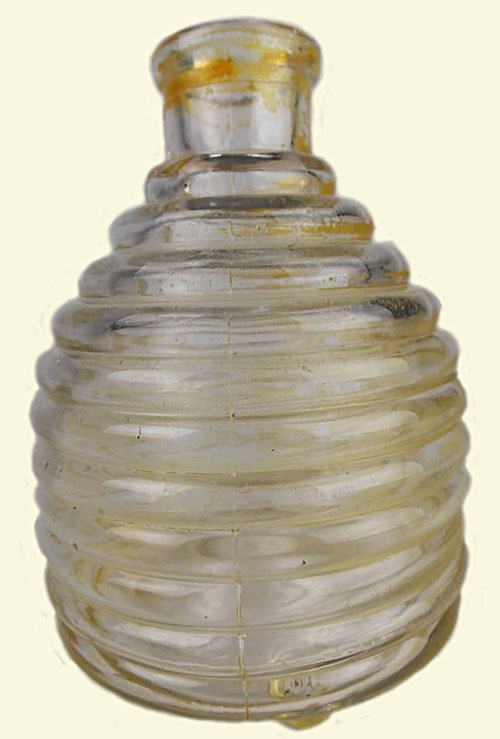
another way I have discovered,
which comes very near to the former, if it does not exceed it, which is to cover flat wide earth pans, all over the bottom with honey or melasses
without water, if there be three or four of these pans placed at a good distance, the whole length of the vineyard every wasp to leeward, that is within
smell of them, will come to the feast, they will soon so entangle themselves in the melasses that, if you attend them, you may make it a deadly
feast to almost all that come; when the wind comes from another quarter, place your pans along another part or side of your vineyard, that so
the wind may blow from the vineyard to the place, from which you would draw the wasps, and so go round till you have destroyed them all.
One circumstance I have omitted with regard to birds, and that is, if poles be stuck up here and there, near that quarter where the birds
harbour and have their haunt, and small branches with three or four twigs on them, be fastened to the top of the pole, and the twigs
well daubed over with birdlime, and the birds will perch upon them, and will be so entangled by the bird-lime that if they are suffered
to continue upon them some time, if they then get away, they will hardly return again that season: and as if they could communicate
to each other their grievances and their dangers, few or none of the same species will come into the vineyard that season.
The same grub, which is a short smooth earth worm, that cuts off the English beans, &c. is very hurtful to young vines, often cuts off the
choicest branches; if the earth were taken away round the root of the vine, about two inches down, and some tar and hog's hard, mixed in equal
quantities, were daubed round that part of the vine, I think, though I never have made the experiment, it would prevent the mischief.
Vine fretters also are often injurious to vines; they are very small animalculae, or insects, of what species, I have
never examined, but they appear in great numbers, in mere clusters, upon the young tender branches, upon the juice of which they feed;
the only remedy I know, is to take away the branch with them upon it, and so destroy them bodily; but if the branch cannot be spared,
they must be mashed and rubbed off by a careful tender hand; if they are chiefly destroyed the first two or three years, they are not
so numerous nor so troublesome afterward.
More about soil.
It is common with gardeners and vignerons, who cannot bear to see a good piece of ground lie idle, to raise a crop of
cabbages, colliflowers or brocoli, between vines when young. This is very wrong and very injurious to vineyards,
for it not only cramps the growth of the vines, but robs the soil of those rich salts and sulphureous oils, which are necessary
to bring the fruit to perfection when the vines begin to bear. The soil cannot be too fresh for a vineyard, provided it be not too rank, and therefore
a fresh new soil, that has never been ploughed, at least not in many years, is always recommended as most proper for a vineyard.
A clean, light, warm, rich soil, that has a great mixture of sand is best; a rank, heavy, stubborn soil is not good, it is apt to
rot the vines, unless it lies high along the south and south-east sides of hills and mountains, the dryness of the situation and the intense
heat of the sun greatly alter such a soil, and meliorate it, they open, warm and sweeten it, by drawing out its cold four bitter nature, and render it fit for
the richest production, so that here the strongest and highest flavoured wines are made.
I have already mentioned the planting of vines at a proper distance, and in this I have exceeded the common distance practiced in most
wine countries; and that for reasons which I shall presently assign.
Experimental husbandry.
When I first undertook a vineyard, I can without the least spark of vanity say, I did it for the good of my country, and from a principle of
love to mankind; I considered that too many of the people of America were unhappily drawn into great excesses in the use of distilled spirituous
liquors, which ruin their constitutions, and soon render them unfit for the service of God and their country, as well as
for that of their own family and friends. Wine on the contrary is a more homogeneous liquor, more wholesome and much better adapted
to the spirit, and constitution of man; and although men will run into excesses in the use of it, yet it works itself off better, and does
not destroy the natural vital heat and animal spirits, in so great a degree and in so sudden a manner, as fiery distilled
liquors do; for these reasons I went on, and endeavoured to make myself master of the subject, and by many experiments to satisfy myself
of the truth of things. I was determined not to take up with things upon trust; for these things are generally conducted according to the
usage and custom of our forefathers, whose method we follow with the same implicit faith, that too many do the religious
tenets, customs and worship of their church, without examining into the nature, reasonableness and soundness of them: But as
reasonable creatures and free agents, I think we have a right to examine things, to search into the nature and reason of them, and
to judge and act for ourselves; and ought not to be tied down to arbitrary rules and rigid customs which have been laid down and
established in times of ignorance and superstition. To assume then a perfect liberty in planting of vineyards and making of wines,
as well as in all other parts of husbandry, I shall now proceed to give such reasons for planting vines at a distance, as are obvious and
clear to me from several experiments which I have made.
The advantages of wide spacing of vines.
If a vineyard lies on a sloping ground and is not too steep to plough, the vines should be planted eight feet from each other every way;
the advantages of this manner of planting I think are many; with a single horse plough, having a foot fixed in the fore part of the beam,
by way of gage, to prevent the plough from going so deep as to cut the roots of the vines; a man with the help of a careful boy to ride and
guide the horse, the horse always supposed to be tame and under good government, may plough a full acre or more in a day, which is as much as six men
will generally dig up with hoes, and is every way much better done, the furrows lying across the descending ground, will very much prevent washing
away by hard rains; the ground lies light hollow and loose, by which means it readily receives all the benefit of the atmosphere, the dews, the
winds, and night air, the mists and soft descending rains, which meliorate and impregnant it with nitre, volatile and fixed salts, and with
oily and sulphureous matter, fit for vegetation and the richest productions, and the Sun more effectually draws out the sour and
bitter nature of the soil, and by its genial heat prepares it for a plentiful production. After this it requires no more
culture for twelve or fourteen days time, or more, according to the weather.
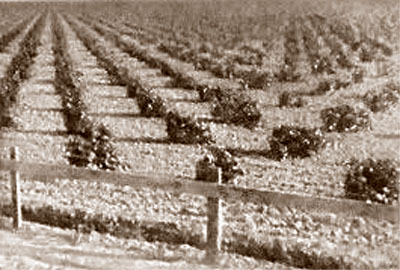
If a drought succeeds the ploughing, it will need no other
stirring 'till rain comes, provided the ground turned up mellow and crumbly, which it will do if it was not wet when it was ploughed, which a
judicious farmer will at all times carefully avoid, for nothing hurts a crop of any kind more than ploughing or harrowing ground when it is wet;
Columella says, that it renders the ground carious, and that it will not recover a proper temper again that season, and this I once found by woeful
experience, which effectually cured me of stirring ground when wet, for any culture whatever. I say, that the ground will not want
stirring again till rain comes, unless by the help of great dews the weeds should appear, it must then be harrowed with a sharp iron tooth harrow; which
the same man, boy and horse can manage; the man if careful and diiligent, can with ease harrow three acres a day, and if this be repeated
three, four or five days, after every rain, or upon the first appearance of weeds, they may with grew ease be kept down. All then that is done
with the hoe is, to keep the rows between the ploughings free from grass and weeds, which are soon run over and the ground kept loose and light,
so as to let in the air, which is of great service to vines; and the more mellow your ground the better it stands a drought; when the vines stand too near,
the work must be done altogether by hand; this requires many more hands, which is very expensive, the work is tedious and almost endless;
the careless hard working man often strikes too deep and wounds or cuts off the roots, the lazy and indolent will not strike deep enough,
besides they all must trample down good part of what they dig, so that the ground cannot be left so loose and light as by ploughing.
Again, when the rows are at a good distance, the vines will not interlock nor shade one another, which is very pernicious,
the wind and air will pass freely through them, which are very refreshing, and greatly help forward the growth, ripeness and sweetness of the fruit; then the
morning Sun, which is comforting and vivifying, will have free access to every plant, will warm the ground, which grows cold by the absence of the Sun,
and by the night air; all will lie fairly open to the more exalted meridian Sun which by its heat brings forward the fruit to full maturity.
Again, when the rows are at a proper distance each way, the roots of the vines will not so greatly interfere with each other;
they will have more room to spread and extend themselves, and collect more nourishment and food for themselves and their offspring.
Vines of four and five years old extend their roots six and eight feet from their stocks; as for the root that shoots downward, nature, for the
preservation of the plant from excessive droughts, darts them down so far as to reach a moisture below sufficient to secure them from perishing.
If then in four or five years they extend their roots so far, how must they interfere and rob each other, when they are planted near, and
especially when they grow old, their roots then are so interwoven that they appear like a piece of net work; this, I think, shews, and plainly proves,
that vines planted three, four, five, or even six feet apart, are quite too near, so that they greatly hurt each other and cannot produce so
good wine.
Again, when vines are planted at a proper distance, a wheel or a hand barrow may pass freely through them, which will greatly facilitate
the dunging of the ground and the gathering in of the vintage; or a horse with panniers on each side, made flat on the side next his body, or a long square
basket fixed on a hand-barrow and slung across two hard boys shoulders, would give dispatch to either work. But farther, men of learning and
observation say, that vines planted at a distance produce the best and richest wines, and to crown all, it is the opinion of men knowing and
experienced in these things, that a vineyard planted at eight or ten feet distance each way, will produce as many grapes, as one planted within
half that distance, though there be twice as many vines; that it will produce larger and finer grapes; will bring its fruit to greater
perfection, and make better wine.
 If a man be poor and cannot procure a horse and a plough, or if his vineyard be small and he chooses to cultivate it with his own
hands, or if his vineyard lies along the side of a steep hill or mountain and cannot be ploughed, in either case the German
double pick, or sparkling iron, is the best instrument for digging a vineyard; the shape you have in the margin: This instrument
digs the ground with more ease than the hoe, and neither cuts nor wounds the roots. It is fixed on the handle like a hoe,
and bends downward as that does.
If a man be poor and cannot procure a horse and a plough, or if his vineyard be small and he chooses to cultivate it with his own
hands, or if his vineyard lies along the side of a steep hill or mountain and cannot be ploughed, in either case the German
double pick, or sparkling iron, is the best instrument for digging a vineyard; the shape you have in the margin: This instrument
digs the ground with more ease than the hoe, and neither cuts nor wounds the roots. It is fixed on the handle like a hoe,
and bends downward as that does.
Stakes.
As stakes are a necessary article, as as on the choice of them depends very much their durableness, I shall mention some sorts
that are most likely to last and do the greatest service. Red cedar, locust, mulberry, thrifty chestnut, that is free from worm
holes, sassafras, or the heart of oak, the heart of yellow pine, such as grow in New-Jersey in dry sandy grounds, I am told will last long
 in some grounds. The stakes must be about an inch and a quarter square, and not less, the biggest end must be sharpened, they stand
the firmer in the ground; if both ends were dipped in boiling tar, the head not above two inches, the lower end so deep so deep
as that the tar may appear above ground when the stake is drove down firm, this will greatly help to preserve the stakes from rotting;
the best way to save your stakes from being battered to pieces by driving is, to have a spike, with a long tapering socket, an inch and
a half bore at top, with a long taper point, well steeled; the whole about fourteen inches long, with a staff fixed in the socket
four feet long, the whole shaped as in the margin; With this the holes for the stakes are made a foot deep, and with a stroke
or two of a mallet, the stakes are firmly fixed, without being split or battered. The stakes should be six feet long,
so as to stand five feet out of the ground, and should be drove by a line and stand strait.
in some grounds. The stakes must be about an inch and a quarter square, and not less, the biggest end must be sharpened, they stand
the firmer in the ground; if both ends were dipped in boiling tar, the head not above two inches, the lower end so deep so deep
as that the tar may appear above ground when the stake is drove down firm, this will greatly help to preserve the stakes from rotting;
the best way to save your stakes from being battered to pieces by driving is, to have a spike, with a long tapering socket, an inch and
a half bore at top, with a long taper point, well steeled; the whole about fourteen inches long, with a staff fixed in the socket
four feet long, the whole shaped as in the margin; With this the holes for the stakes are made a foot deep, and with a stroke
or two of a mallet, the stakes are firmly fixed, without being split or battered. The stakes should be six feet long,
so as to stand five feet out of the ground, and should be drove by a line and stand strait.
The Roman frame.
The Roman frame, which served instead of espaliers in ancient times was plain, cheap and frugal, fit for farmers, and such as every farmer
can find, on his own plantation, without any other expence besides his own labour: This shews the economy and prudence of that great
and wise nation, whilst they were a commonwealth. It consisted of strong stakes or small posts fixed well in the ground in a strait
line six feet high, and three rows of poles tied fast to them one above another, and fifteen inches apart, the upper pole being four, five
or six feet from the ground, according to the age of the vine, over the upper pole the bearing branches were laid, looking toward the fourth,
and were fastened to the pole, and this they called precipitating a vine, when the branches were grown long enough, they were fastened to
the middle pole, and then to the lowermost, and when they came near the ground they were cut off. The branches were regularly disposed so as
each might have the benefit of the Sun and air, by being fastened to stakes drove down here and there, along the frame; they were trimmed and
managed in other respects, just in the same manner as those directed for espaliers; and indeed from these frames the espalier was taken.
Binding the vines to the stakes.
The materials proper to make bands of, to bind the vines to the stakes are, the sweet flag, otherwise called the calamus aromaticus.
These long flat leaves cut in June and dried in the shade, and then bundled up and kept in a dry place for use do very well, but then
they must be made wet when you bind with them. The long flat leaves of reed, the rushes and three square that grow in marshy or
meadow ground preserved and used in the same manner do as well.
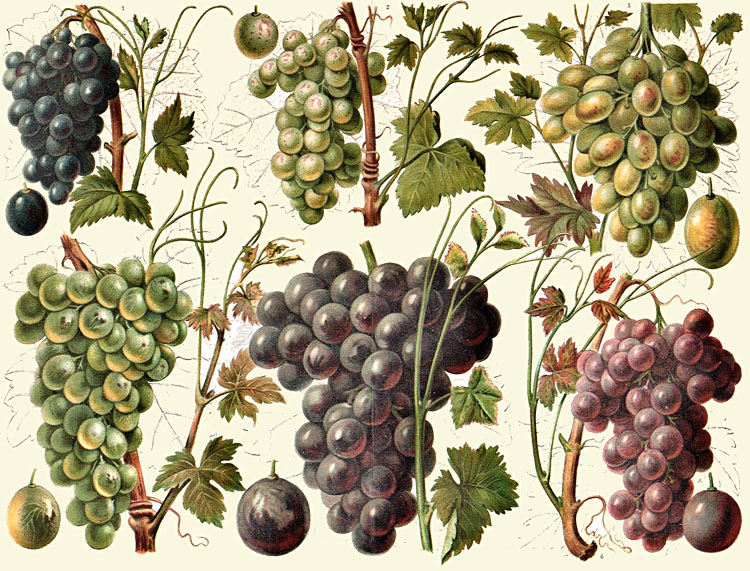
The making of wine.
Having now gone through the necessary directions for planting and managing vines for vineyards, I proceed to the making of wine,
a subject though short and easy, yet calls for great nicety and exactness. The making, fermenting and preserving of wine is a mystery
to the people of America, but when the methods of managing these things are brought to light and explained nothing appears more
simple and easy; but before I proceed to this work, it will be necessary to give some directions about gathering the grapes,
since that work must be done before we can make wine.
As my countrymen are generally strangers to all these things, I hope they will bear with me, if sometimes I am more particular
than to some it may seem necessary; since I would willingly remove every obstable out of the way, and communicate every the most minute
circumstance to those, who are altogether strangers to this new undertaking in America, so that any man of common sense, that can read,
may safely undertake and go through with the whole affair successfully.
Gathering grapes.
I have already observed, that the black grapes differ from the white in the manner of ripening, but whether your grapes be black or
white, they must be fully ripe before they are gathered, otherwise they will not make good wine; gather them in a fair day, when they
are perfectly dry; take away all the rotten and unripe grapes from every cluster, for they spoil the wine:
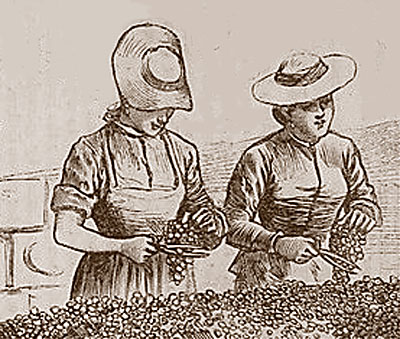
If your vintage be large and
you gather more grapes than you can mash and press out in one day, let them be gathered without bruising, for bruised
grapes soon contract an unsavory taste and hurt the wine in proportion; if they are mashed the same day they are gathered, the bruising
will do no hurt; nevertheless I would advise the gathering of them to be directed by some grave discreet person, for as this work is done
generally by servants and children, it is made matter of pastime and frolic, rather than prudent labour, and so many grapes are
torn off, and either bruised or scattered on the ground, to the no small damage of the owner, both in the loss of fruit, and in hurting
the wine, and these things should be impressed on the minds of the gatherers before they begin, that every thing may be done regularly
and in order by which means more work will be done, and to much better purpose.
The black grapes are best known to be ripe, when here and there one of the forwardest grapes begins to shrivel and dry; then set to and gather and
make them up into wine as fast as you can.
If white frosts happen before some of your grapes are fully ripe through very near it, so as to want no farther feeding, you need be
under no apprehensions about them, let them still hand on the vines, they will grow ripe, rich and high flavoured notwithstanding;
but then they must be gathered before the weather be so hard as to freeze the grapes, for that will spoil them; the light frosts that only
kill the leaves do not hurt the fruit, unless it be such as are late ripe, these should be carefully covered from all frosts,
they should grow against walls or board fences fronting the south or south-east, and at night be covered with mats or frames
thatched with straw, which should be so contrived as to be set up to cover the fruit or let down at pleasure.
Correlation between weather and wine quality.
A pretty good judgement may be formed of the goodness or badness of your wine, and of a plentiful or thin vintage,
by the seasons of the year; if the spring and former part of the summer prove generally dry, with now and then moderate refreshing
rains, if the season in August and September be hot and dry, if in the month of June the wealther be hot and dry, if in the month
of June the weather be calm, serene and dry, when the vine is in blossom, and the fruit is forming, your crop or vintage will be
plentiful, and your wine rich and good: But if at the time of blossoming, the season be wet and stormy, the winds high and blustering,
if the spring be cold with much wet, and backward, if the latter part of summer and fall be stormy, raw and wet; your crop will be thin, and the
wine small and bad; when this happens, it will be necessary and for your advantage, to boil one half of the must, and to manage it as I
shall hereafter direct you.
Pressing and fermenting white grapes.
As the wine made from black grapes has a different management from that made of white grapes, I shall begin with the white;
these then must be gathered as I mentioned before in a fair day, when the grapes are perfectly dry; and both the rotten and unripe grapes
being carefully plucked off from every bunch, the clusters are then thrown into the mash vat, and two or three men, acording to the quantity,
having washed their feet and legs very clean in bran and water, get into the vat and trample and mash the grapes thoroughly so that none escape,
the more they are trampled and mashed the better;
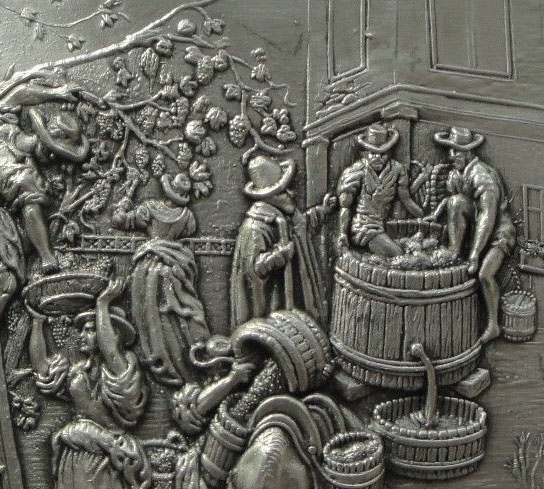
about Paris they let the musk, that is the skins, stalks, must and all stand together
in the vat eight and forty hours and then press it off, but in other parts of France they press off as soon as the grapes are mashed:
The last method I should prefer, provided the husks be trod over again in the Portuguese manner, otherwise I should prefer the first
method practiced by the people about Paris, for this reason, because there is a rich pulp that adheres to the skin of the grape,
which is not separated by the first treading; but by lying eight and forty hours in the murk, and the vat covered with sheets or blankets,
which is the practice, a pretty strong fermentation has begun and continued some time, which partly dissolves and partly loosens this rich
pulp, that stuck to the skin, which then chiefly comes away by pressing; however I am of the opinion that, the treading of these husks
after the fermentation, the must having first run off into the receiver, would do the work more effectually if they were well pressed
after it.
But then we must take this caution along with us, that if vines are young, which always afford a thin weak wine, or if the seasons have been
wet and bad, so that the juices are not rich, in those cases the must should be boiled before any fermentation, in order to preserve
the wine (as I shall farther direct you when we come to the boiling of wines) in that case the Portuguese method must be pursued, because the
boiling of wine after the fermentation has begun, would entirely spoil it; the sweet must only, as it runs from the treading into the receiver,
must be boiled.
The first and second pressing being mixed together is put into hogsheads, which must be filled within four inches of the bung,
that it may have room to work and ferment, the casks being placed in some warm room or dry cellar. Then having a small spile fixed in the middle
of the head of the cask, the third or fourth day, draw a little of the wine in a glass, and if it be pretty fine, draw it off immediately into a
clean dry well scented cask, the larger the better, so you have wine enough to fill it, which you must do within two inches of the bung, and stop
it close, leaving only the vent home open for a second fermentation; after a few days it will work a second time, but not so much as at the
first; if your wine be strong and good, which you may know by the age of your vineyard, and by the goodness of the seasons, it will be
best to leave the bung hole open for this second working, the wine will be the better: for strong wines require a greater fermentation than
weak wines, and the stopping of the bung hole, is a check upon the working, and prevents weak vines from spending themselves too
much, which must greatly hurt them; on the contrary if strong wines have not a thorough working, they are apt to grow thick and ropy,
which hurts them as much the other way; by this you may form a proper judgment what degree of fermentation is proper for the wine that is
under working and govern yourself accordingly.
Three or four days after the second fermentation begins, which you must carefully watch by visiting your wines every day, again try
your wine in a glass, and if it be pretty fine, prepare a cask sweet and good, burn a good large brimstone match in it, and as soon
as the match is burnt out, whilst the cask is full of smoke, draw off the wine into it; now fill up your cask to the brim, and bung it
up tight and stop the vent hole; the smoke or the brimstone will hinder any further fermentation; and this is called stumming:
then make a morter of clay and horse dung mixed up with strong flaxseed tea, and cover the bung and vent hole close with it, and so let it
stand until it is fit to sell or to use.
When you first rack off your wine, if you have any old wine that is rich and good, of the same kind or colour, but four or six gallons of it,
and two gallons of good brandy into your cask (this quantity is sufficient for an English hogshead) and then rack off your wine into it for the
first time, this will greatly strengthen and preserve your wine, and if your wine be weak, it will hinder too great a fermentation the second
time, and so preserve the purer spirits from flying off.
When wine is in fermentation, all the gross parts are thrown up to the top of the cask, or vessel that it ferments in, and there meeting the air,
they undergo a very great change for the worse, they contract a hardness and become rancid. If they are suffered to pass through the body of
the wine, which they certainly will do, as soon as the fermentation is over, they will communicate those evil qualities to the wine, and it
must be a strong wine indeed that will stand such a shock. If the wine be weak it will soon turn sour; if the wine be strong and has a
sufficient stock of native spirits to defend it from those bad impressions, yet it will contract an unsavoury harshness, which will not
be removed for some time, nor will it be fit for drinking until age has smoothed and made it mellow.
For this reason it is that you are to draw off your wine both times before the fermentation be quite over, and as to weak wines, they
should by no means work too much, either time, three days are quite sufficient for each working; strong wines should work longer for
the reason above assigned; they are better able to stand it, besides it prevents ropiness and they find the sooner and better for it.
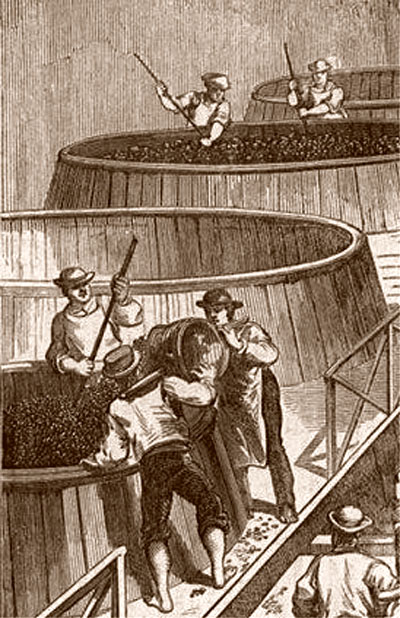
Pressing and fermenting red wines from black grapes.
I now pass on to the making of red wines from the black grapes. Red wines have a different management from the white; the whole
of one or even two days treading or mashing, (when the vintage is great) is thrown into a large vat, the must, stalks, skin and all, and stands
in some warm dry place or cellar. The vat is covered close with sheets or blankets, or both, and thus it remains,
according to custom from four to seven or even ten days, according to the coldness or heat of the weather. This is done to obtain
a strong fermentation, in order to give a deeper colour to the wine, and this is the only end proposed by it; the manager of this work, visits
the vat twice a day, and in a glass views the colour of the wine, and tastes it; if the tincture be not deep enough to his mind, he knows
by the taste of the wine, whether it will stand a longer fermentation: if it will not, he contents himself with the colour it has
and draws and presses it off, and fills it into casks, leaving about two inches from the bung, for a second fermentation.

When the second fermentation is over, which generally happens in four or five days, he then draws it off into clean well scented casks, and adds
to it six gallons of good old wine and two gallons of brandy to an English hogshead, which contains from 60 to 63 gallons.
Where the same kind of wine is not to be had, he makes use of port wine. He then fills the cask quite full and bungs it up tight,
leaving only the vent hole open to let out the generated air. Note, when I say, where the same kind of wine is not to be had he makes use of
Portugal wines, this is mentioned for our practice, not that the French make use of such wines, for they always have wines enough of their own
of the same kind.
This management of red wines, which perhaps with little variation, is almost as ancient as the making of wine in France, deserves some attention
and a close examination, in as much as I am fully persuaded that it is capable of an essential improvement.
To understand the nature of this affair rightly, we must know that, besides the main pulp or core of the grape, which is white in black grapes
as well as others, there sticks to the inside of the skin, a considerable body of rich pulp, which is perfectly red, of a deeper die in some than
in others. This pulp gives the colour to the grape, according to the lightness or deepness of its tincture: thus we see some grapes of a light red,
some of a full red and some of a deep red, some again are almost black, some quite black and some of a shining jett; this same pulp also
gives the tincture or colour to the wine, for the same grape is capable of making white wine as well as red wine; if the main core which
is first trod out, be only used, the wine will be white; thus they make white Burgundy, &c. but if the red pulp be mixed with it, it makes it of
a rich purple colour; as this is a clear case and lies exposed to every discerning eye, the great point of improvement to be gained, is to
dissolve or extract this rich pulp, without injuring the wine.
The problem.
That the present method is the best and most effectual to that purpose, I can by no means think; the violent fermentation through which the wine
is made to pass, in order to procure the tincture, must exhaust the spirits in a very great degree, and leave the body in a weak and languid state,
and subject it to harshness, to turn eager or vapid in a short time; these wines grow worse not better by age; many instances of this kind
we meet with in the French clarets, among which, where one hogshead proves good, sound and wholesome, ten, not to say twenty, prove harsh, eager and disagreeable:
These considerations lead me to think, that the present management calls loudly for a reformation; one experiment I have made, and but one, which I shall offer
with some farther thoughts to consideration for farther improvement; but I most heartily recocmmend this affair to some public spirited and
worthy philosophers of the age, who by repeated experiments might bring to light this important secret, which when known would be very beneficial
to the nation.
An experiment.
The experiment I made was this, in a clean stone pot, wide and open, containing two gallons, I squeezed as many Burgundy grapes as nearly filled it,
with the liquor and skins; the stalks I left out. It stood in a dry room covered with a coarse dry towel four double, four days and nights fermenting,
I then strained it off and with my hands mashed the skins very well, by this means I obtained a full deep tincture of that kind of purple
that is peculiar to the Burgundy wine; I then left it to ferment, in a large case bottle, after the first and second fermentations were over, I found
about a quart of rich sediment at the bottom and a pretty thick skin forming on the top, the smell was very pleasant and truly vinous,
the just indications of a sound healthy wine.
By this experiment I found that, three days fermentation, allowing the first day for heating,
which is preparatory to fermentation, (the degrees of heat are mentioned by Boerhaave, Hoffman and others) was sufficient to obtain a tincture,
with the help of squeezing the skins a second time, without injuring the wine, and I found what red pulp remained adhering to the skins, separated from them very
easily, and by the colour of the wine, before the second squeezing, that the fermentation had dissolved most of this pulp, or extracted
a great part of its tincture; from the whole then, I think I have reason to conclude, that if the husks or skins, after four days lying in the murk,
were taken out and thrown into the mash vat, and heartily trod over again, and especially if some of the must, or rather wine, for it is
wine after fermentation, be now and then thrown over the husks, as they are trampling it in order to wash away the pulp,
that a full tincture may be obtained, without torturing the wine, as the present manner is, and without running so great a risque of spoiling it.
As this is a very important point, upon the right management of which depends the goodness of the wine, and as a farther improvement
is hereby designed, I have dwelt the longer upon the subject, and therefore hope it will not be looked upon, as a useless digression.
Helping thin and weak wines.
Wine made from young vineyards is always thin and weak, and so are wines from old vineyards, when the seasons have been cold, stormy and wet,
and without some assistance, they will not hold sound long; now this is given two ways, either by the help of some old strong wine, one
fourth part at least, and four gallons of brandy to an English hogshead, or if that is not in your power, then half of the must is to be boiled
away to one half of its quantity, that is, if one half of your must contains forty gallons, that must be boiled away to twenty, this
greatly enriches it, and makes it of the consistence of liquid honey. As soon as it is cool, mix it with the rest of the must, and let it
ferment together, and then manage it as before directed of other wines; when your vineyard comes to be ten or twelve years old, it will yield much
stronger wines.
The boiling of your must is managed in the following manner, which must be carefully attended to; your copper or kettle being well cleaned, rub the inside all over
with a woollen rag dipped in sweet oil, which preserves the wine from contracting a nauseous, copper or brass taste; then throw in your must, and kindle
a gentle fire under the copper with brush or small split wood, your copper standing so high, that the wood need not touch the bottom of it,
when you put large wood under it to make it boil fast; for if at any time your wood touches the bottom of your kettle or copper, the wine will be
burned, which will spoil it; as the scum rieses skim it off, and gently raise your fire by slow degrees, stirring your must often from the
bottom, and take off the scum as it rises, till all be clear, then raise your fire by larger wood, and make it boil faster and faster,
as it settles down or boils away, till one half be consumed, being always careful and upon the watch that none of the wood touches the bottom of the copper;
the must thus boiled away is called defrutum, or the rob of grapes. If you neglect to raise the sediment from the bottom of the copper, it will burn
and spoil the wine, for it turns bitter.
And now once for all I must caution every one, who attempts to make wine, to be strictly careful to have all the vessels and instruments made use of in
this work, perfectly clean and sweet; for if they have any sour, unsavoury or offensive smell, they will communicate it to the must
and spoil the wine; and every thing that has an offensive or disagreeable smell, must be removed from the place where wine is made, and from the cellars where
it is kept; the cellar ought to be dry and warm; for damps or wet hurt wines exceedingly. It must also be free from mustiness, and in good
weather, the windows next the south and west must be opened, to admit the warm dry air, which will prevent mustiness and dangerous damps.
Hogsheads well bound with iron are the only safe casks for wine, if you trust to old wine pipes, or to hogsheads with wooden hoops, it
is ten to one but they deceive you; they constantly want repairing every year, but iron bound casks will hold many years without any expence
at all, so that in three years time they become by much the cheapest casks; I mean for standing casks, out of which the wine is racked
into other casks for sale; but then as soon as they are empty, the lees must be taken out and saved for distilling into
brandy, and the same day the cask must be filled with water, or else they will be destroyed by a small worm, which will pierce it like a five.
Every man that has a vineyard should have a still and good worm, that he may distill all the lees, the husks and the scum into good brandy,
which he will want for the preservation of his wines, the same still will do to make peach brandy and the spirits of cyder, which will soon
pay for it. A still that holds a barrel is quite large enough, unless your vineyard and orchards be very large indeed.
Managing wine after fermentation.
I now pass on to the different management of wine after fermentation; one method I have already mentioned; some after the second fermentation,
leave the wine in the same cask upon the lees, and adding the old wine and brandy to it (for which they make room) they stop up the
bung hole, and leave only the vent hole open to let out the generated air, till the month of March, filling up the cask from time to time
as the wine subsides or wastes, and then draw it off into a clean, well scented and well stummed cask, and stop all close with morter.
Others again in the month of March, before they rack it off and stum it, roll the cask backward and forward in the cellar to mix
the lees thoroughly with the wine, thinking thereby to communicate the strength of the lees to the wine, and then let it stand and settle till it is fine,
and rack it off into clean well stummed casks, and stop and plaster all up close.
Here I think it proper to take notice, that the lees of strong wines may be of advantage, and communicate some to the wines
that produce them; for, as I have already observed, the lees, in the time of fermentation, being thrown up to the top of the vessel, there meet with the air,
and being exposed to it for four or five days, contract a harsh and rancid nature, if they do not grow quite sour, and then subsiding,
as soon as the fermentation is over, and settling to the bottom of the cask, where they are left for the wine to feed upon, I leave it to any man
to judge what kind of food this must be, and what manner of good it can communicate to the wine. But what shall we say, so rigid
and arbitrary is custom, that we even look upon it next to rebellion, to deviate or depart from the customs of our fathers.
Cyder exhibits similar problems with pumice as wine does with lees.
The cyder that has been made in America for above one hundred years past, has till very lately, been constantly spoiled by this same mistake.
Every man that makes cyder very well knows, how soon the pumice corrupts and grows sour by being exposed to the air, and yet no
man in all that time ever prevented the pumice, after fermentation, from settling down through the whole body of cyder,
but there left it to remain for his cyder to feed upon all winter, and indeed all the next summer too, if it lasted so long;
with this additional advantage, that in the spring upon a fresh fermentation, the same body of pumice rises again to the top of the cask and
there contracts a still greater acidity or rancid nature, and by sinking down again through the body of liquor, communicates a still
higher degree of these rare qualities to it, and then the owner complains of the hardness of his cyder, and so does every body else
that drinks of it; and yet this has so long remained without a remedy, because our fathers did so.
From what experiments I have made, I am clearly of opinion that the fæces or lees which are left in wine or cyder is the true cause of
their frequent fermentation; nature appears to be loaded with, and sick of them, and like a man with a foul stomach, often strains hard
for a discharge, and the neglecting to ease and clear nature of this pernicious, this destructive load, is the chief cause of all the
ill effects it produces. In this, the juice of the grape resembles the blood, the vital juice of man, if by a foul stomach any
quantity of crude, indigested or vitiated matter be thrown into the blood, it is presently set into a
ferment, which rises and increases till either the matter be fully discharged, or the vital union be dissolved; if the man recovers
the shock, and gets the better of the mighty struggle, yet how weak, how low and faint does he appear!
Thus it fares with wines, the strong bodied wines that are replete with spirits, often get the better of these struggles, but
I believe not without considerable loss and damage; but the weaker wines generally sink under them. It is from this idea of the thing,
that I have all along so strongly insisted upon the removal of the lees in the beginning, upon the first as well as the second fermentation.
Philip Miller's experiment, as it relates to the problem with lees.
I should be greatly pleased if the ingenious and Reverend Dr. Hales, of Teddington in Great-Britain, would, by experiments, bring
this matter into a clearer light; the world would be obliged by him, as we have already been, by a discovery which he was so good
as to make not long since in a case that bears some relation to the present one; I shall transcribe it as it is related by the ingenious
Mr. Philip Miller, in his Gardener's Dictionary [Philip Miller, 1768]: viz.
"A great complaint I received from a curious gentleman in Italy, of the spoiling of their best and finest wines there;
who says, such is the nature of this country wines in general, (nor are the choicest Chianti's excepted) that at two seasons of the year,
viz. the beginning of June and September, the first, when the grapes are in blossom, and the other when they begin to ripen,
some of the best wines are apt to change, especially at the latter season; not that they turn eager, but take a most unpleasant taste,
like that of a rotten vine leaf, which renders them not only not fit for drinking, but also unfit for vinegar, this is called the
septembrine, and what is most strange, one cask drawn out of the same vat, shall be infected, and another remain perfectly good, and yet
both have been kept in the same cellar.
"As this change happens not to wine in bottles, though that will turn eager, I am apt to attribute it to some fault in fillings the casks, which must always
be kept full; which either by letting alone too long, till the decrease be too great, and the scum thereby being too much dilated,
is subject to break, or else being broken by filling up the cask, and being mixed with the wine, gives it that vile taste: But then
against this there is a strong object, i.e. that this defect only seizes the wine at a particular season, viz. September, over which,
if it gets, it will keep good many years: so that the case is worthy the inquiry of naturalists, since it is evident that most wines are more or
less affected with this distemper, during the first year after making.
"Upon receiving this information from Italy, I consulted the Revd. Dr. Hales of Teddington, who was then making several experiments
on fermenting liquors, and received from him the curious solution of the cause of this change i wine, which I sent over to my friend in Italy,
who has tried the experiment, and it has accordingly answered his expectation, in preserving the wine, he thus managed, perfectly good.
He has also communicated the experiment to several vignerons in Italy, who are repeating the same, which take in Dr. Hales own words, viz.
"From many experiments which I made the last summer, I find that all fermented liquors do generate air in large quantities, during the time
of their fermentation; for from an experiment made on twelve cubic inches of Malaga raisins, put into eighteen cubic inches of water the
beginning of March, there were four hundred and eleven cubic inches of air generated by the middle of April; but afterward, when the fermentation
was over, it resorbed a great quantity of this air; and from forty-two cubic inches of ale from the ton (which had fermented forty four
hours before it was put into the bolt head) there were generated six hundred and thirty-nine cubic inches of air from the
beginning of March to the middle of June, after which it resorbed thirty-two cubic inches of the same air; from whence it is plain,
that fermented liquors do generate air during the time of their fermentation, but afterwards they are in an imbibing state, which may account for
the alteration in the nice Italian wines,*"
*
Had Dr. Hales been asked what he thought was the true cause of those frequent fermentations, and was desired to apply a remedy; I think he would have
sought for the cuase, where it was to be found, and upon removing that, the effects would naturally have ceased; but being put upon the search of secondary causes,
causes far removed from the original, in order to prevent or cure the evil effects of them, he resolved that difficulty, I do suppose in the
best manner it could have been done, and with great ingenuity applied a remedy. And now,
should these pages fall within his ken, or some friendly letter comprehending my full meaning, the Doctor, as a true philosopher, from a
public benevolent spirit, would soon find out the true cause of these mischiefs, and apply a remedy, truly specific.
The gentleman in Italy, who makes the representation to Mr. Miller says, "And what is most strange, one case drawn out of the same vat,
shall be infected, and another remain perfectly good;" in this case it is certain, that the first and second cask drawn out of the vet,
and the third and fourth, if the vat be large, were drawn off fine and clear, being perfectly free from the fæces or lees below,
but when the last cask comes to be drawn, a good deal of the lees come with it, and this is not much regarded, as the lees were supposed to
nourish the wine; suppose the gentleman complaining had the first and the last cask drawn out of the vat, and one of them spoiled, the other
remained perfectly good, which shall we suppose to have been the case! That which was perfectly fine, or that which has the lees? Whoever will
taste the first and the last drawings, will find so sensible a difference in the wine, that I think he cannot be at a loss to determine the question.
Secluding the air from wine or cyder, is a great means of preserving them long sound and good; nature itself points this out to us;
wine forms a scum upon the top to secure itself from the bad impressions of it, and we daily find that these liquors put into bottles,
keep much better than when left in casks; some think that strong old Madeira is an exception to this rule, but I think it has not had a fair
and impartial trial. That cyder drawn out of a barrel grows worse and worse as air gets to it, every one is sensible of, whereas some of the same cyder bottled,
remains good a long time, if well corked and refined, as every body knows; and that this is the case with common wines, no man will dispute.
 For this reason the lining of the inside of the casks with rosin, as the Romans did with pitch, prepared as hereafter directed, would be a great
means of preserving wine, not only from the air but from great waste; and the bung and vent-hole should be well secured with clay and horse dung:
if you are under apprehensions that the rosin will communicate a bad taste to the wine; melt it, and wash it with lye, and that will prevent it.
The Doctor's method of keeping the casks full is very ingenious and of great service.
For this reason the lining of the inside of the casks with rosin, as the Romans did with pitch, prepared as hereafter directed, would be a great
means of preserving wine, not only from the air but from great waste; and the bung and vent-hole should be well secured with clay and horse dung:
if you are under apprehensions that the rosin will communicate a bad taste to the wine; melt it, and wash it with lye, and that will prevent it.
The Doctor's method of keeping the casks full is very ingenious and of great service.
The tubes, represented in the margin, perhaps may be a small improvement upon his, this double tube is supposed to be made of pewter or tin,
well soldered together; the small tube enters the large one at the bottom, below the wine, and does not break
the scum that is on the top of the wine in the large tube; the large tube should be well stopped with a good close screw head, and this must be opened when wine
is poured in through the small tube, and presently stopped again, that the cask may always be kept full, and to keep out the air.
[E.A. Esq.]
for wine during the first year after making, continues fermenting more or less during which time a great quantity of air is generated,
until the cold in September puts a stop to it, after which it is in an imbibing state, that is, it draws or sucks in air;
the air thus generated is of a rancid nature (as the Grotto del Canno) and will kill a living animal if put into it, so that if there be,
during the fermentation, two quarts of this air, so rancid, pent up in the upper part of the cask, when the cold stops the fermentation,
the wine by absorbing this air becomes foul, and acquires this rancid taste; to prevent which I would propose the following experiment:
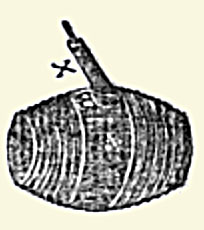 Suppose the vessel A, filled with wine, in the bung-hole B, of this vessel I would have a glass tube of two feet long and about two
inches bore fixed with a pewter socket closely cemented, so that there may be no vacuities on the sides; and in this tube should be another of
about half an inch bore, closely fixed; the lower tube should be always kept about half full of wine, up to X, which will supply the vessel,
as the wine therein shall waste or subside, so that there will be no room left in the upper part of the vessel to contain generated air,
which will pass through the upper small tube, which must always be left open for that purpose; and the tube being small, there will be no
danger of letting in too much air to the wine: As the wine in the large tube shall subside, it may be replenished by introducing a slender funnel
through the small tube down to the scum upon the surface of the wine in the large tube, so as to prevent its being broken by the wines
falling too violently upon it; this will be prevented by the wines being poured in gently with a small stream.
This experiment being tried with glass tubes will give an opportunity to observe what impression the different states of the air have upon the wine,
by its rising and falling in the tubes; and if it succeeds it may be afterward done by wooden or metal tubes, which will not be so
subject to breaking.
Suppose the vessel A, filled with wine, in the bung-hole B, of this vessel I would have a glass tube of two feet long and about two
inches bore fixed with a pewter socket closely cemented, so that there may be no vacuities on the sides; and in this tube should be another of
about half an inch bore, closely fixed; the lower tube should be always kept about half full of wine, up to X, which will supply the vessel,
as the wine therein shall waste or subside, so that there will be no room left in the upper part of the vessel to contain generated air,
which will pass through the upper small tube, which must always be left open for that purpose; and the tube being small, there will be no
danger of letting in too much air to the wine: As the wine in the large tube shall subside, it may be replenished by introducing a slender funnel
through the small tube down to the scum upon the surface of the wine in the large tube, so as to prevent its being broken by the wines
falling too violently upon it; this will be prevented by the wines being poured in gently with a small stream.
This experiment being tried with glass tubes will give an opportunity to observe what impression the different states of the air have upon the wine,
by its rising and falling in the tubes; and if it succeeds it may be afterward done by wooden or metal tubes, which will not be so
subject to breaking.
This curious experiment having succeeded, where ever it has been tried, will be of great service in the management of wines; there being many useful hints to be
taken from it; particularly with regard to fermenting wines; for since we find that wines too long fermented (especially those which are made in
cold countries) do seldom keep well; so by letting them stand in a cool place, the fermentation will be checked, which will render the wines foul, and subject
them to turn eager; therefore great care should be taken to keep the wine in an equal temperature of air, which may be known by hanging a thermometer in the vault.
But after the wine has passed its fermentation in the vat, and is drawn off into casks, it will require something to feed upon: And when the wine has remained
one year upon the lees it is commonly drawn off into other vessels, it will then also be proper for it to have something to feed upon; about four pounds
of the best Malaga rains picked clean and stoned, and thrown into each hogshead, will be sufficient and best for that purpose,
more would be dangerous, by raising a new fermentation, which always hurts the wine more or less according to the greatness of it. As the wine will subside
by waste as long as it continues in casks, it is the usual method to fill them up from time to time, with some wine, as nearly like the same sort as may be; for if
it be of a different nature or much newer, such as has not thoroughly fermented, it will often raise a new fermentation, which will endanger the wine:
Therefore, if you have no such proper wine, it will be best to throw in as many clean washed pebbles and well dried, as will raise up the wine
to the bung: This I have know practised with success." Thus far Mr. Miller.
Some observations on this matter.
Here I must beg leave to make some observations, which may either serve to throw a light upon this affair, or lay a foundation for farther
experiments, in order to come at the truth, which in all cases is worth pursuing, and especially in this, where it has lain
dormant for so many ages, and the discovery would be of great importance to the present design.
The principles of wine are an inflammable spirit, a phlegm or watery liquor, an acid salt or tartar, and a sulphureous oily substance;
wines therefore greatly differ in their taste, smell and virtue, according to the various proportions and manner in which these principles
are combined. Perhaps the difference of flavour, taste, colour and body in wines may be owing as much to the time of gathering,
manner of pressing, the different degrees of fermentation, &c. as to any difference in the grapes themselves;

in Hungary, whence Tockay
and some of the richest and highest flavoured wines do come, they are extremely curious in these respects; for their prime and
most delicate wines, the grapes are suffered to continue on the vines till they are half dried by the heat of the sun, and if the sun's
heat should not prove sufficient, they are dried by the gentle heat of a furnace. Wines that are thin may be improved by freezing,
by this means the watery parts adhere to the cask, and the strong spirtuous parts are left in a body, in the middle of the cask, and being
drawn off by themselves, prove strong and good, and will keep well. See Hoffman, and the celebrated Dr. Stahl on this
subject; see also Dr. Shaw's comment on Stahl.
If these be the real principles, and some of the essential constituent parts of the grape, or if a proportionable quantity of nitre be
allowed to come into the composition, which might perhaps be discovered by an accurate analysis, it will not be hard to account for
the fermentation; heat and air both are necessary to it; now these principles whilst confined to the grape, are so disposed by the wise
Author of Nature as to be confined distinctly in their proper cells or tubical ramusculi, and they are so closely secured by the covering
of a skin of such a compact texture, like that of bladders of several kinds, that the air cannot come at them, but they are effectually
secured against the impressions of it; if this, or something like this be the case, then these principles remain in a neutral or inactive
state, whilst thus confined to the fruit, but when the fruit comes to be mashed, and these principles come in contact of each other, and are
exposed to the warm air, which is of a very active and elastic nature, the whole body, by degrees, is put into motion, the motion begets
heat, and the heat increases the motion, (this heat and the increase of it is plainly discernable by the touch, 'till it
increases to such a degree, as according to Boerhaave, is necessary to a full fermentation. The heat then increasing
to a farther height, the fermentation gradually abates, and thus ends the first fermentation:
By this operation a spirit is generated, and the mild, soft, lucious juice of the grape, which is called must, is changed into a brisk, lively,
inflammable spirit, which is then called wine; which has, if closely and attentively considered, a strange and wonderful effect upon those that
drink it, according to their different dispositions, humours and constitutions.
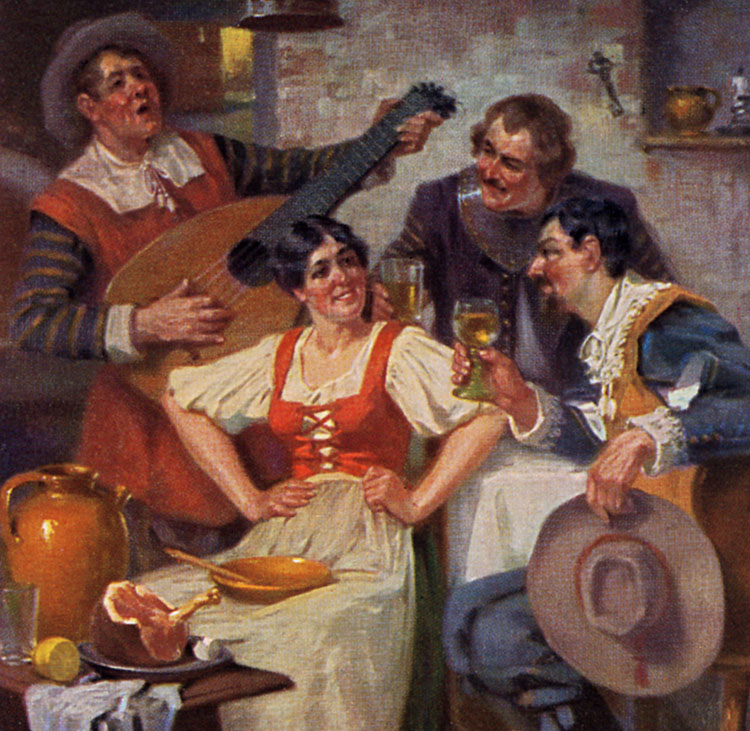
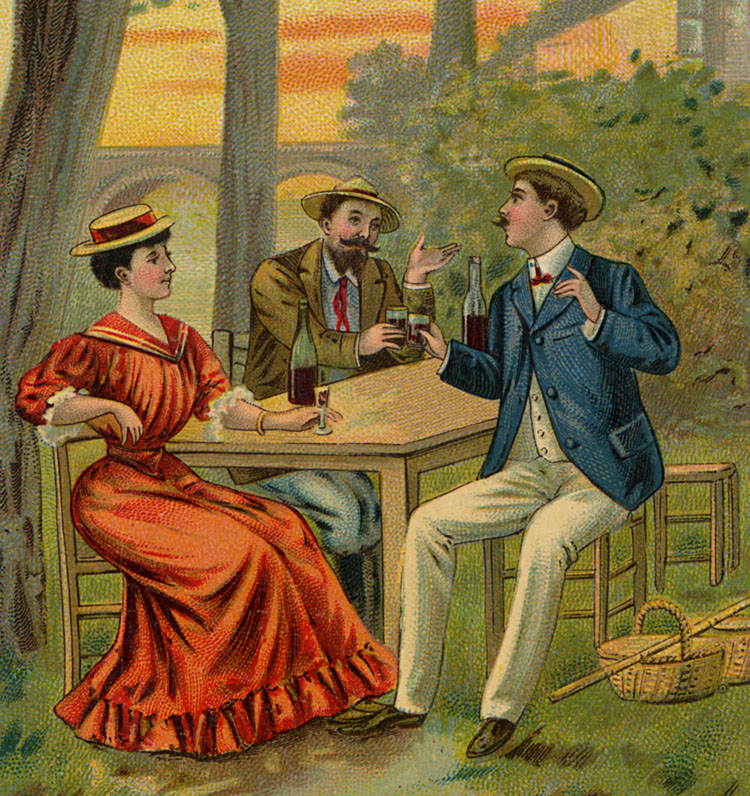
By the violent motion of this first fermentation, all the fæces or gross parts are thrown up to the top of the vessel, and this is a proper
time, at the end of three, four or five days, according to the strength of the wine, which is then pretty clear, to draw it off from those
grosser parts; which will be done without loss, and the lees must be preserved for distilling into brandy. If this be neglected, this gross
body having been so long exposed to the air, contracts a rancid nature, or turns sour, and as soon as the fermentation is over,
it gradually sinks down to the bottom, and passing slowly through the body of the liquor, communicates those
evil qualities to it:
This is so clearly discernible in cyder which also is a tolerable good wine, when properly managed, that no man can be mistaken
in the case. Since I have taken this method with cyder, it has proved more like wine than common drink, but then I racked it off a second
and a third time, as soon as it appeared fine, and then strummed the cask that received it the lasttime: This cyder will keep sound all
summer in a cask, and grows stronger, and may be bottled at any time, it will soon ripen, and be very brisk when poured into a glass, and
that without endangering the bottles so much, its briskness proceeding from spirit, and not from fermentation.
Weak wines will by no bears bear so great a fermentation as strong wines, let them therefore be drawn off after
three days fermentation the first time, and adding two or three gallons of brandy, and five or six gallons of good old wine; stop up the
bung, and leave only the vent hole open, and when the second fermentation is just over, and when the wine is pretty fine, draw it off a second time
into a well stummed cask, fill it up to the brim, and stop all close, and keep it so 'till you sell or use it, and then bottle it.
Some customs among the ancients, I think are worthy of notice, and fit to be revived and retained by us; how many of them came to be laid aside,
when they appear so useful and beneficial, I cannot say, perhaps for reasons which I am not able to discover: I shall here mention one,
which I think pertinent to our present purpose, which was for the preservation of their wines; they took a firkin, or eight gallons of pure
clear tar, of the first cool running from the kiln; to this they added half as much good clean pitch pounded fine, and put it all into an iron pot,
and melted it by a gentle fire; when hot they put to it four gallons of strong lye (that is a lixivium of ashes,) this they stirred altogether,
at least for half an hour very well, it was then left eight and forty hours for the tar and pitch to subside, the lye was then poured off;
the tar and pitch was heated till it melted a second time, and four gallons of fresh lye were poured on, and stirred and managed as
before; this was done a third time; they then took four gallons of sea water, as salt as could be got, (for people who cannot easily
come at the sea water, a good clean brine, made of salt and water, may do as well) the tar and pitch being just melted, but not made too hot,
they put the salt water to it, and stirred it very well, this was put in the sun, and stood open all day, but covered at night to keep off the dews,
and when it rained; this stood exposed to the sun till all the water was exhaled, and then it was put up for use.
With this they payed or daubed over
the cask, into which they put the wine, in this manner: They took out one head of the cask, and in the same manner as our coopers do,
they heated the cask thoroughly, and having some of the pitch and tar, (now more resembling pitch alone) melted, they threw as much as they thought
would daub the cask all over, and also the head that was taken out, they then took a broom and rubbed the pitch well over every part of the inside
of the cask, so that no spot escaped, turning and winding the cask about very briskly; for this work must be done in hurry, least
the cask and pitch cool, in which case the pitch grows so thick and hard as to refuse to be spread: By this management of the cask,
it was made perfectly tight, all the pores of the wood were stopped, the wine was preserved from waste, which wine merchants very well know is a great saving, and
well deserves the trouble and expence, and the spirits of the wine, which are always active, and striving to fly off through every pore,
are greatly preserved, and the air without, which pressed hard to insinuate itself through every pore, is effectually prevented.
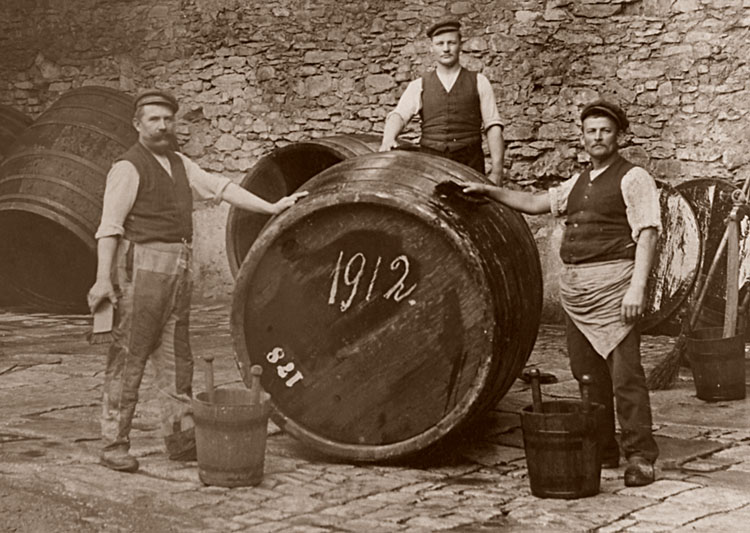
If men that sell rum, or any other spirituous liquors, could at first afford to have good iron bound casks, for constant standing casks
to keep their liquors in, and draw it off as they sell it, they would soon find themselves great gainers by this practice. I think
rosin and turpentine well washed with lye in the same manner, would be sweeter, and answer all the purpose; or indeed rosin alone would do as well.
Suggested experiments.
I shall now propose the management of some small quantities, in different manners, by way of experriments, in order, if possible,
to arrive at some tolerable perfection in this new undertaking.
1st. Let a keg of four gallons be filled three-fourths with murk, that is, with the must and skins of black grapes, for making of red wine,
(the skins having been well squeezed) before any fermentation; let the bung hole be stopped close, and leave the vent hole open, to let out
the generated air, and after the second fermentation fill up the keg with old wine, and let the vent hole remain open, and let it stand so till February,
then draw it off, and manage it as occasion shall require; if it be clear, sweet and good, bottle it, so shall you have pure genuine wine with
its own peculiar flavour; if you find it thin and weak, you must help it as in other cases.
2d. Let a keg of four gallons be filled with the wine that is drawn off, after the first fermentation is over, the keg having first been well stummed,
stop all close, and let it stand till February, if it then be fine bottle it, if not, stum a second keg well, and draw it off, and stop all close,
and let it stand till the next winter; if it then be fine, bottle it; if not fine it down, and then bottle it for use: If, at the second racking,
you find it thin and weak, add some brandy and old wine to it.
3d. Let white grapes hang on the vine a month after the vintage is over, let others hang till they shrivel, make trial of these at different times; let them be
mashed as much as possible without breaking the grape stones, let them stand in the murk two, three, or four days, well covered with a blanket
three or four double, then drain off the wine, and mash the skins very well over a cullender the second time; then strain out the stones,
washing the skins very well with the wine, till all the pulp, that sticks to the inside of the skins, be got off, fill your keg with this wine three-fourths,
and fill up the rest with good old wine, stop up the bung, leaving the vent hole open till the second fermentation is over, then stop the vent hole,
and let it stand till February: I think this wine will be good; but then in all these cases the vent hole must now and then be just opened,
to let out any generated air, lest the keg be in danger of bursting. As soon as the air puffs out stop it again, that as little air as possible,
may get in.
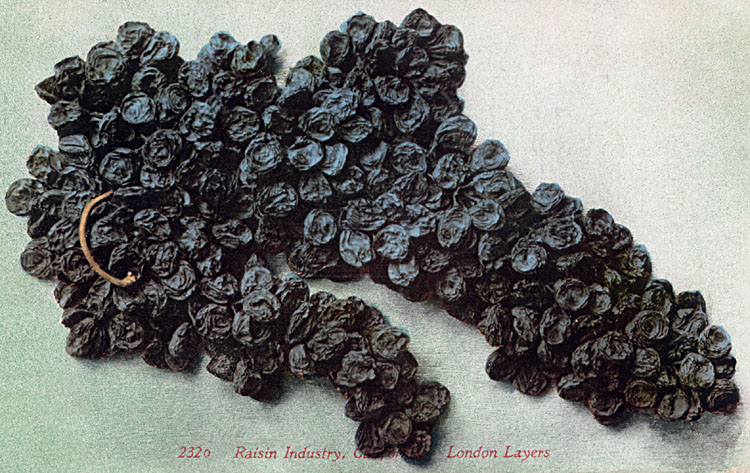
By varying these experiments, you may at last come at the most perfect way of making, fermenting and preserving of wines: It is now said, that wines cannot be
preserved without brandy, how then did the ancients preserve them? I think they may be preserved pure and perfect by their own strength, when a vineyard
comes to a proper age (which I will suppose to begin at twenty, and so last till seventy or eighty) if the grapes are suffered to hang
on the vines till they are perfectly ripe; but people, partly from a fondness of getting done before their neighbours, and partly from a desire of making a little
more wine, and some from the apprehensions of a rainy season, hurry on this work before its time, and often, very often, become great sufferers by it.
Native American vines.
The reason for my being silent about vines that are natives of America, is, that I know but little of them, having but just entered upon a trial of them,
when my very ill state of health forbad me to proceed: From what little observation I have been able to make, I look upon them to be
much more untractable than those of Europe, they will undergo a hard struggle indeed, before they will submit to a low and humble state, a state of
abject slavery: They are very hardy and will stand a frame, but they brave the severest storms and winter blasts, they shrink not at snow,
ice, hail or rain; the wine they will make, I imagine from the austerity of their taste, will be strong and masculine.
The fox-grape, whose berries are large and round, is divided into three sorts, the white, the dark red and the black; the berries grow but thin upon
the bunches, which are plain without shoulders. They delight most in a rich sandy lome, here they grow very large and the berries are sweetest, but they will
grow in any grounds, wet or dry; those that grow on high dry grounds generally become white, and the colour alters to a dark red or black,
according to the lowness and wetness of the ground; the situation I think must greatly affect the wine, in strength goodness and colour;
the berries are generally ripe the beginning of September, and when fully ripe they soon fall away; thus much I have observed as they grow wild.
What alteration they may undergo, or how much they may be improved by proper soils and due cultivation I cannot sayl
There is a small black grape, a size bigger than the winter grape, that is ripe in September; it is pleasant to eat, and makes a very pretty wine, which I have
drank of, it was four years old, and seemed to be the better for its age; the colour was amber, owing to the want of knowing how to extract
the tincture; this grape is seldom to be found; there is a vine of them near John Taylor, Esq. at Middletown, Monmouth, and there are some of them in
Mr. Livingston's vineyard at Piscataqua in New-Jersey. I think they are well worth propagating.
The frost or winter grape is known to every body, both the bunches and berries are small, and yield but little juice, but the richness of the wine
may make up for the smallness of the quantity; the taste of the grape is austere till pretty hard frosts come, and then it takes a favourable turn
and becomes very sweet and agreeable; this vine shoots forth great numbers of slender branches, and might do very well for the south and south-east
sides of a summer-house or close walk, if all the useless and barren branches were cut away.
The vines of America are fit for strong high espaliers, but if I mistake not, he must watch them narrowly, must take away every unnecessary
and unprofitable branch, and trim them sharp and close, that means to keep them within bounds.
We see that the vines of this country have a covering of bark of so close and firm a texture, that they stand all weathers without injury,
they fear nothing but a frost after they put forth the tender bud: We see that cold winds and winter blasts have a great effect upon the
human body, they brace up and confirm all the solids, harden and strengthen the whole frame, and renders a man active, brisk and lively in all
his motions: They have likewise a wonderful effect upon the brute creation; the covering of sheep, cattle and horses, in hot countries, is
very thin and cool, remove them into a cold region, sheep soon acquire a covering of wool, horses and cattle a thick coat of hair. Why then
should not vines by being transplanted from a warm into a cold region, acquire a firmness and covering suitable to their new situation?
I believe by a proper management they may be degrees be inured to colder countries, but such a hardness must not be supposed to be
acquired all at once, but by being winter after winter, a little more and more exposed to the severities of the weather, they may in a few
years, in a great measure, be reconciled to such a climate as ours:
But then I would have it remembered that, late ripe fruit will not do as yet to the northward of the capes of Virginia; it is the early ripe
fruits, that the bread colonies must propagate, 'till the climate becomes more temperate, by the country's being cleared further back;
none that ripen after October will suit us at present, and the latest we raise, should arrive at full maturity by the end of that month.
In twenty years I make no doubt November will be as favourable a month as October is now.
Method of curing Grapes for Raisins
Method of curing Figs
Observations on the raising and dressing of Hemp
...
The utensils necessary for the making of wine.
And now to conclude the whole, as my countrymen are unacquainted with the utensils that are necessary for making of wine, it is necessary that I
say something on that head.
First then according to the size of your vineyard, you must have a number of cheap crooked knives, the shape of pruning knives, but a little more bending,
to cut off the clusters from the vines; for pulling them off, is very difficult, it is attended with great waste of fruit, and is very destructive
to the vines;
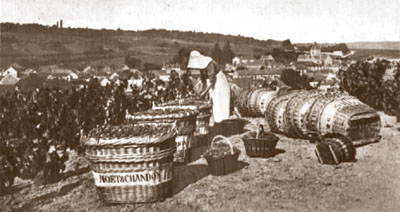
you must also have a number of handy baskets, to put the grapes into, as you cut them, and also a large wicker basket or pannier,
which is of a long square form, fit
to place on a good light handbarrow, with leather strops at each end to hand on the shoulders of two hardy boys, who may trot away with it to the
mash vat, as soon as it is full; or else it may be carried in a wheel-barrow, if hands are scarce, or you have have two panniers made fit to hang across
a horse's back, being made flat on one side for that purpose.
Then you will want a mash vat big in proportion to your vineyard and the age of it, this must
have a false bottom full of holes made with a twenty-penny gimblet,
but not larger, least the grapes get into them, it must lie upon a curve firmly fixed, about six inches above the true bottom; you will also want
a receiver, which is a pretty large tub, placed partly under the mash vat, to receive the must as it runs from it; if your vineyard be large you will also
want a kedlar, which is a large vat or ton, for fermenting the murk that you make red wines of, and perhaps for that of white wines, if you choose to make
wine of them after the manner of Paris. If your vineyard be not large the mash vat may answer the purpose.
You will also want pails and dippers and a large funnel to ton with:
A smart close screw press, to go with one or two screws as you like best, with a wicker frame and hair bag to fit it, and proper followers to press clean and dry
must be had without fail; and last of all good sound strong iron bound butts or hegsheads, which are really cheapest and the only casks you can depend upon, what makes them far
preferable to others, is, they are always tight, they want no trimming, only a little driving once a year, if they stand empty any time and they last
good for many years, if they are well painted and dried till the smell of the paint goes off, otherwise they would communicate that ill smell to the wine.
In conclusion.
And here my dear countrymen I must repeat to you what I have already endeavoured to inculcate, which is, that every thing must be kept sweet and clean;
if by carelessness, inattention or hurry of business, you suffer your press or any of your vessels, your tubs or casks to grow sour
or musty, they will certainly ruin your wine, for nothing in nature is sooner tainted than must or new made wine. And let me persuade
you to avoid one great error, which most farmers run into, about their cyder, least that custom be put in practice also with wines; they put their cyder into fresh
rum hogsheads, under the notion of preserving the cyder strong and good, but they destroy the fine flavor of the apple, and instead
of an agreeable vinous liquor, your nose is offended with a strong hogo, and you taste nothing but the fumes of a rum hogshead, so that no gentleman,
no man of taste or delicacy, will buy it; now should you make the same mistake with your wines, you would certainly spoil them, were they otherwise never so good,
so that no man would buy them.

It has been the general opinion of mankind that wines ought to have something to feed upon, but this notion is very wrong, for most things that are put into wine
raise a fermentation in a higher or lower degree; and it is agreed that every after fermentation hurts wine more or less; if wine be weak put in brandy and old strong wine,
these are the proper strengtheners and preservers of wine; strong wine wants nothing but clean racking, and all wines should be racked till they are fine.
A double handful of clean coarse salt may do good.
Perhaps I have not said enough upon taking away day roots from vines the first three or four years of their age, but let me now tell you that, it is of great consequence,
and it is the chief means of preventing the grapes from bursting.
And now my dear children, countrymen and fellow-citizens, I have faithfully led you by the hand throughout this new undertaking; take my blessing
and cordial advice along with it, be not drunken with wine wherein there is excess, but be ye rather filled with the spirit of wisdom,
for too much wine, like treacherous sin, ruins and destroys the true happiness of the soul. And may the God of wisdom crown all your honest labours with success,
and give you a right understanding in all things.





